Posts Tagged ‘Logging’
Monday, December 5th, 2011
The following comments were posted by Tigerquoll 20111102, on Tasmanian Times to the article ‘Tasmania’s longest running forest blockade celebrates 5-year milestone‘, by Miranda Gibson, Still Wild Still Threatened (20111101), which began…
.
‘Today “Camp Flozza” celebrates its fifth birthday. The forest blockade has been running continuously for the past five years, holding off logging operations in the Upper Florentine Valley’. [Read More].
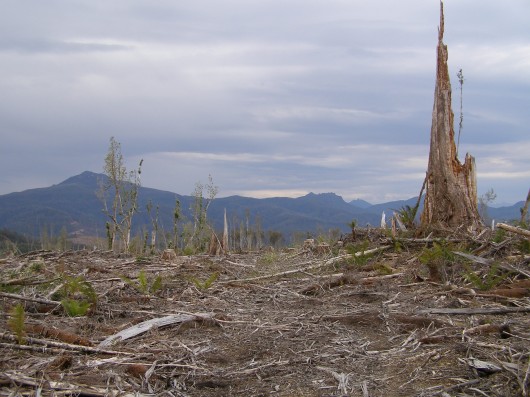 Styx Valley Holocaust
– old-growth clearfelled by Forestry Tasmania
(Photo by editor 20110929 – free in public domain)
(Click photo to enlarge, then click again to enlarge again) Styx Valley Holocaust
– old-growth clearfelled by Forestry Tasmania
(Photo by editor 20110929 – free in public domain)
(Click photo to enlarge, then click again to enlarge again)
.
“A Conservation Agreement halting logging in 430,000 hectares is now over-due. The Intergovernmental Agreement signed in August explicitly states that logging operations must be rescheduled or where this is not possible compensation given. Every hectare of forest lost in this area now represents a complete breach of the promises made by the government.”
.
~ Miranda Gibson, Still Wild Still Threatened
.
.
Of old growth defenders:
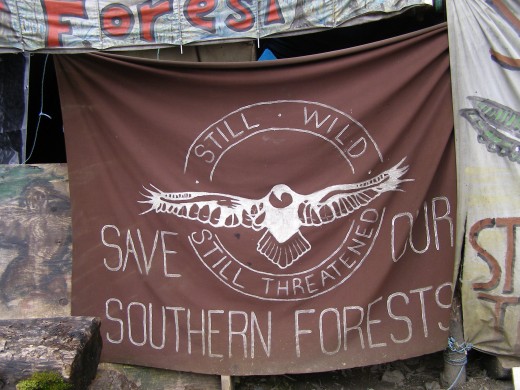
“Here’s to the crazy ones, the misfits, the rebels, the troublemakers, the round pegs in the square holes… the ones who see things differently—they’re not fond of rules… You can quote them, disagree with them, glorify or vilify them, but the only thing you can’t do is ignore them because they change things… they push the human race forward, and while some may see them as the crazy ones, we see genius, because the ones who are crazy enough to think that they can change the world, are the ones who do.”
~ Steve Jobs [1955-2011]
History will recount – the steadfast commitment by these forest defenders to hold their ground, to dig in, in the face of an overwhelming enemy, compares to the dusty amateurs that became the rats of Tobruk.
.
Of old growth rapers:
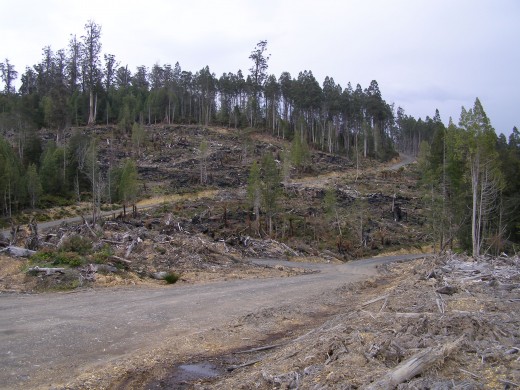 Styx Valley hillside clearfelled – beyond Forestry Tasmania’s locked gates.
(Photo by editor 20110929 – free in public domain)
(Click photo to enlarge, then click again to enlarge again) Styx Valley hillside clearfelled – beyond Forestry Tasmania’s locked gates.
(Photo by editor 20110929 – free in public domain)
(Click photo to enlarge, then click again to enlarge again)
.
A morally-wise person would not put down an animal because it was injured. Moral civilized society has evolved the ‘Veterinary’ profession – a highly skilled field, more highly qualified than human ‘General Practice Medicine’ – why?
In the wild, a female mammal may kill an impaired offspring only to save its remaining healthy young scarce food to survive.
In Tasmania, old growth forests are becoming scarcer by the day, and yes this is still occuring in the 21st Eco-Century, not the 19th Timbergetting Century.
But in the selfish eyes of industrial loggers, any broken branch justifies the clearfell and scorched earthing of old growth forests by the hectare, which are innocuously relegated as ‘coupes’.
What then is a coupe? A forest coupe is earmarked for logging. A selected section of an intact, pristine native old growth forest is earmarked by Forestry Command for ‘harvesting‘, read ‘logging‘, read ‘forest ecology slaughter‘, read ‘forest wildlife habitat destruction‘. Yet to the logger mind forest reads as plunderable timber, and these days as low grade commodity woodchip to greedy asian profiteers, only to sustain a diehard, got-no-where-to-go desperate logger culture. The log-till-I-drop logger mentality is no different to morbidly obese American juveniles confessing dependence on Maccas Big Macs.
I fear loggers would do same to their grandparents once impaired.
‘Corporate industrialism’ is worse than Herbert Spencer’s ‘survival of the fittest’ mindset. It is self-serving Forest Eugenics – evident in Forestry Tasmania’s programmed conversion of native Tasmania into plantations and the scourge of its genetically modified Eucalyptus nitens now exterminating Tasmania’s next condemned species – the Tasmanian Devil.
Beware the Forest Nazis lurking in the privets.
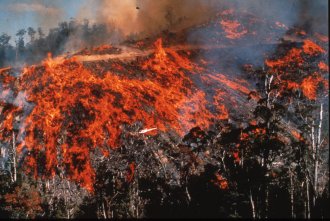
Holocaust is what the Nazis did
This is what Forestry Tasmania did recently to The Tarkine.
.
 ‘Forest Eugenics’ is what Forestry Tasmanian ‘scientists‘ are doing today – ‘Forest Eugenics’ is what Forestry Tasmanian ‘scientists‘ are doing today –
GM-modified Eucalypt nitens plantations replacing native Old Growth
.
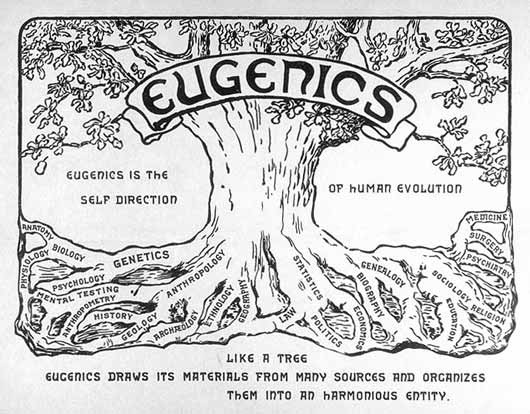 Is this where GM Nitens (shining gum) is taking Tasmanian ecology – to ‘elite forests’?
– superior growth rate, disease resistant, herbicide resistant, but perhaps the GM-exterminator of Tasmanian Devils. Is this where GM Nitens (shining gum) is taking Tasmanian ecology – to ‘elite forests’?
– superior growth rate, disease resistant, herbicide resistant, but perhaps the GM-exterminator of Tasmanian Devils.
.
Tags: Camp Flozza, Eucalyptus nitens, Forestry Tasmania, Intergovernmental Agreement, Logging, old growth, Still Wild Still Threatened, Styx Valley Holocaust, Tasmania, Tasmanian forest eugenics, Tasmanian Times, The Tarkine, Upper Florentine Valley
Posted in Tasmania (AU), Threats from Deforestation, Threats to Wild Tasmania | No Comments »
Add this post to Del.icio.us - Digg
Friday, October 21st, 2011
 Stihl Concrete Saw Stihl Concrete Saw
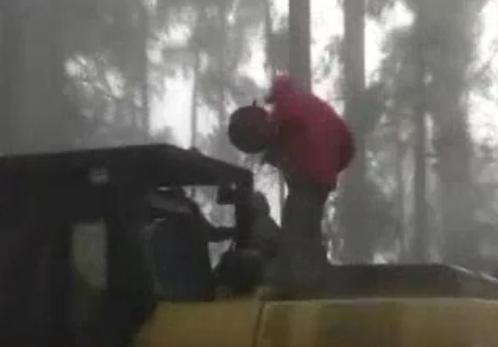 Stihl Saw Nutter – contracted with Forestry Tasmania, October 2008 Stihl Saw Nutter – contracted with Forestry Tasmania, October 2008
(Click photo above to play video in YouTube, turn up your PC volume)
.
 Stihl President – Fred Whyte
(Billings Gazette) Stihl President – Fred Whyte
(Billings Gazette)
.
In September 2010, Fred J. Whyte, president of STIHL Inc., was elected chairman of the Outdoor Power Equipment Institute (OPEI) during the association’s 58th annual meeting in Coeur D’Alene, Idaho.
.
“I am honored to again represent STIHL and the outdoor power equipment industry as chairman of the OPEI board,” said Whyte.
“In this next year, we hope to accomplish a lot, especially in the realm of educating the public on the safe and efficient use of outdoor power equipment. We are seeing gains in the market, which should be welcome news to all OPEI members. Let’s hope we return to our market prosperity with new sustainable programs and products that will lead us into the next generation.”
.
[Source: Stihl USA, ^http://www.stihlusa.com/pressrelease/september10_FJWOPEI_corporate.aspx]
.
.
Two years prior (2006) …’Defending Tasmania’s ancient forest’
.
[Source: Tasmanian Times, 20061106, ^http://tasmaniantimes.com/index.php?/article/defending-tasmanias-ancient-forest/ ]
.
‘This week has marked a new chapter in the defence of Tasmania’s ancient forests with 17 arrests in the Weld Valley, Southern Tasmania.The arrests occured whilst community members were trying to prevent an access road that will allow the chainsaws into majestic ancient forests.The Weld Valley has now become one of the largest resistance campaigns for Tasmania’s forests in the last decade. Community outrage at this senseless devastation is challenging the Tasmanian and Australian governments to give these wilderness forests the protection they deserve.
For more than a year, forest defenders built and lived in a beautiful conservation haven that worked to hold the chainsaws and bulldozers at bay. Camp Weld, had a full size replica Pirate ship (the Weld Ark), a bush cabin and the entire infrastructure needed to provide shelter and support to friends of the forest. The camp had a village style atmosphere and was open to all comers who wanted to help the forests in their plight. Camp Weld members faced not only the hostility of the weather, the driving rain, winter dark and snow but also the very real hostility and threats from logging industry supporters.
.
‘Through the year, Camp Weld faced gun shots, car burnings and physical threats from loggers coming directly into camp.’
.
All this was greeted with the strength and commitment of non-violent action and this peaceful response is a testament to the bravery and beauty of the people who lived there.
On Wed 15th November 2006, more than 60 Police raided the camp with one immediate arrest and a lone tree-sitter escaping to her lofty perch.Everyone else was ordered to leave or face arrest under a new media and public exclusion zone placed around a 10 kilometre radius of this state owned forest. For the next 6 days a set of rolling actions began and continue, flowing from the anger at the loss of such a direct action icon and the coming loss of these wondrous forests. People climbed tree-sits, stood in front of machines and some forest defenders locked theselves on to machinery. These actions occurred day after day as the arrest tally climbed to the present 17.
.
For 5 days, the lone tree sitter ‘Pixie’ sat in her high platform watching the events unfold..
Two other forest defenders spent nights in jail as Police used legal tactics to try and prevent the arrestees from returning to the forests. The Tasmanian government has funded this operation to secure access for Gunns Ltd, providing large numbers of police, security, a 24 hour mobile operations base and satellite communications equipment, all to ensure that the bulldozers get into the forest. Yet despite these obstacles people continue to challenge the destruction in a peaceful and defiant manner.
.
Classic non-violent style
.
On two separate occasions, a community walk in was staged to defy the archaic exclusion zone created on public land. The first walk in had 40 people, the second over 100. These were great days for the forests as smiling people walked past security and police, in classic non-violent style. The strength in numbers meant that the police were unable to implement the exclusion zone procedures, which involves individually approaching each person in the zone. The veil over this hideous environmental crime had been lifted.This type of protest has occurred because of the continued failure of the Regional Forest Agreement (RFA) and the subsequent Community Forest Agreement, which were set up under the pretence to solve the forest debate in Tasmania. In fact, things in the forest have gotten worse, roads continue to be cut into high conservation value forests and logging is planned for many high conservation value forests and wilderness areas across the state. A downturn in the woodchip market has not deterred the world largest hardwood woodchipper, Gunns Ltd from continuing their devastation of the island’s wildlife and trees. Their aggressive response to criticism is to sue conservationists and environmental groups with a blanket multi-million dollar civil case.This almost billion dollar company and its $65million man, John Gay, have a strangle hold on the states politicians and its old growth forests.
The Weld Valley is a shining example of places ignored by the chainsaw mandate of the RFA; it is an ancient forested valley of towering trees, moss filled rainforest gullies, snow-capped mountains, wide plains, crystal clear streams and wild Weld river. The original Tasmanians wandered this valley some 20,000 years ago evidence of their lives still remain in the national park protected ‘Bone Cave’ in the upper Weld. The potential for more sites or caves remains unexplored in much of the logging slated lower Weld Valley. While some 80% is protected in the South West World Heritage Area, the remaining forests suffer a very different fate to those separated by the imaginary protection line.
These remaining forests of the lower Weld Valley have been recognized by local and international environmental groups, the United Nations and even Tasmania’s Parks and Wildlife as having equal conservation status to the rest of the valley. Viewed as a single wilderness area, the Weld Valley is a unique landform which has a rare combination of outstanding biological, geological and cultural features naturally linked by continuous forest to the World Heritage Area.
Direct action has always been an area of last resort for conservationist. Brave and often reluctant heroes staff this front line with sometimes little more than their own bodies. Placing lives on hold and committing all for the forests. Basing actions on non-violent principles, that has served people and social movements like Gandhi, the Suffragettes, the Civil Rights struggle and our own Franklin River campaign. As long as companies like Gunns Ltd are allowed, by governments, to ignore community concern and run rampant through our ancient forests with chainsaws and bulldozers then there will always be people willing to stand in their defence.’
.
[Adam Burling is a founding member of the Huon Valley Environment Centre, a part time advisor to Senator Bob Brown and a Gunns 20 defendant.]
.
Tags: activists, Camp Weld, Caterpillar, Community Forest Agreement, Direct action, forester violence, Forestry Tasmania, Fred Whyte, Logging, Martin Bryant, old growth forest, Outdoor Power Equipment Institute, stihl chainsawing old-growth, STIHL Inc., Stihl President, Stihl Saw, Stihl Saw Nutter, Stihl woodchipping old growth, Tasmanian Police, Weld Valley, William Adams, World Heritage Area, www.stihlusa.com
Posted in Tasmania (AU), Threats from Deforestation, Threats to Wild Tasmania | No Comments »
Add this post to Del.icio.us - Digg
Friday, August 26th, 2011
 Who does one believe?… Who does one believe?…
Greenwash Tick
.
.
.
Tuesday 23-Aug-2011:
‘Paper manufacturer loses green credentials’
by Liz Hobday, ABC News, 20110823, ^http://www.abc.net.au/news/2011-08-23/paper-manufacturer-loses-green-credentials/2851982/?site=melbourne, accessed 20110825]
.
The Wilderness Society says Australian Paper cannot meet environmental standards. The manufacturer of Reflex paper has lost part of its international environmental certification, after withdrawing from an audit of its wood supplies.

The Forest Stewardship Council was auditing Australian Paper, to check that the wood used to make Reflex paper is not sourced from high conservation value forests.
Luke Chamberlain from the Wilderness Society says the company withdrew from the process, because it cannot meet environmental standards.
“The makers of Reflex paper get their wood from the Victorian State Government native forest logging arm VicForests,” he said.
 “VicForests log in endangered species habitat. They log old growth forests in East Gippsland and the central highlands” “VicForests log in endangered species habitat. They log old growth forests in East Gippsland and the central highlands”
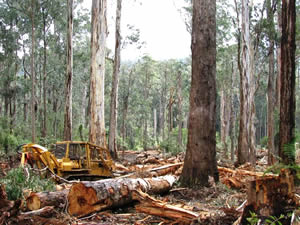
Australian Paper says its products are not sourced from high conservations value forests threatened by logging.
Shaun Scallan from Australian Paper says they withdrew because the audit process changed while it was underway.
“We pulled out because of a change in the definition of part of the standard late in the piece, which did not allow us enough time to then satisfy that changed definition,” he said.
.
.
Meanwhile the same Shaun Scallan of Australian Paper just the day prior on Monday 22 August 2011 posts his media release:
.
‘Australian Paper retains FSC Chain of Custody Certification’…?
by Shaun Scallan, Australian Paper, 20110822, ^http://australianpaper.com.au/media/2478/AP%20FSC%20audit%20release%20FINAL%20Aug%2022_2011.pdf, accessed 20110825
.
‘Australian Paper has successfully retained Forest Stewardship Council (FSC) Chain of Custody certification (FSC-C002059) in its latest audit. Auditor Rainforest Alliance confirmed that under the certification Australian Paper may continue to produce FSC-certified product based on sourcing of material from FSC-certified operations and recycled content, as allowed under the FSC rules for Mixed and Recycled product.
.
“We are pleased to have retained our FSC Chain of Custody certification,” Australian Paper CEO Mr Jim Henneberry said.
“Australian Paper has held Chain of Custody certification since 2006. However, we have decided to remove the Controlled Wood component from our certification at this time as there has been uncertainty around the interpretation of key elements of the standards.”
.
“Advice received by Rainforest Alliance from FSC International around the interpretation of the Standard was received after the physical audit had been completed. This left insufficient time for us to address and so we elected to withdraw Controlled Wood from our certification.” Mr Henneberry said.
.
Australian Paper remains committed to ensuring that fibre supplies come from internationally recognised, third party certified sources and also regards the Australian Forestry Standard and PEFC as benchmark certifications under this policy. The majority of wood supplied to Australian Paper is certified to the Australian Forestry Standard.
.
“We are also continuing to consult with a wide range of stakeholders as part of our Future Fibre Strategy review,” Mr Henneberry said.
“It is vital that we achieve the best balance between the environment, the health of regional communities and our ongoing competitiveness. We look forward to sharing outcomes from this review in due course.”
.
.
Meanwhile, we have the boss of Nippon Paper (the Japanese company that owns the misnomer ‘Australian Paper’) declaring Nippon Paper is going gang-busters to become a top global pulp and paper company…(at any cost?)
 ‘Since I was appointed president of Nippon Paper Group, Inc. in 2008, I have been pursuing “growth-oriented management.” This means exploring every possibility with a consistently positive stance, actively seizing opportunities, achieving the growth needed to become one of the top pulp and paper companies worldwide, as set out in the Group Vision 2015, and developing corporate value that meets the expectations of all stakeholders.’ ~ President of Nippon Paper Group, Yoshio Haga. [Source: ^http://www.np-g.com/e/about/president.html] ‘Since I was appointed president of Nippon Paper Group, Inc. in 2008, I have been pursuing “growth-oriented management.” This means exploring every possibility with a consistently positive stance, actively seizing opportunities, achieving the growth needed to become one of the top pulp and paper companies worldwide, as set out in the Group Vision 2015, and developing corporate value that meets the expectations of all stakeholders.’ ~ President of Nippon Paper Group, Yoshio Haga. [Source: ^http://www.np-g.com/e/about/president.html]
 . .
.
Meanwhile, the stated Charter of Nippon Paper Group includes:
.
‘6. Active involvement with environmental issues assures that…’
.
- ‘We shall promote afforestation projects, to create and make effective use of sustainable forest resources.’
- ‘We shall promote energy conservation, the use of wastepaper and other measures to effectively use resources that are limited in quantity.’
- ‘We shall manage and reduce all types of discharge and waste generated in the course of corporate activities.’
- ‘We shall research and develop manufacturing technologies, and products and services that are in harmony with the environment.’
.
[Source: ^http://www.np-g.com/e/about/charter.html#shead2]
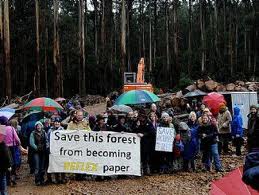
Editor: It is suspicious when a Japanese company is more than content to log and irrevocably destroy another country’s old growth forests, while Japan’s own old growth forests around Mt Fuji remain sacrosanct.
‘In spite of the abundant natural resources, logging is not commonly practiced in the forests of Japan. Japan Forests are venerated and protected since they provide essential soil cover and help in water conservation. All Species are encouraged to grow in the Forests in Japan , from the broad-leaved deciduous to the evergreen coniferous types. There are also many forests which grow near volcanic areas, destroyed and then rejuvenated every time an eruption occurs. The Aokigahara Forest at the base of Mount Fuji is one such forest. Locals as well as tourist camp, trek and hike through these dense forests of Japan to explore their unusual natural beauty.
‘Some Japan Forests are designated as Sacred Forests . These forests generally contain an ancient religious Shrine, usually worshiping the Shinto religion and are protected from trespassing and destruction. These forest shrines are still venerated as national treasures.
.
Some of the sacred forests in Japan are-
- The Forest of the Yahiko Jinja has many trees like the Cedar, Cypress and Oaks. The Shrine has a sacred Chinquapin tree as well.
- The Forest of Atsuta Jinja is an important Shinto Shrine, housing one the three important Shinto relics – the holy sword of Kusanagi-no-tsurugi. The forest has evergreens like the Japanese Camellia Sakaki, camphor trees, Ilex and Japanese Honeysuckle.
- The Forest of Kashima Jingu has over 800 species of trees like varieties of Cedar, Fir and Oak. The Kashima Jingu is an important shrine of the Kanto Area. The forest has been designated as a Wildlife Protection area for the rare birds in the region.
- The Forest of Shimogamo Jinja covers over 495 hectares and has many different species of deciduous trees like the Zelkova, the Elm and the Hackberry. The Shrine itself has 53 buildings which have been designated as National Heritage Architecture.
- The Forest of the Kirishima Jingu covers and area of 887 hectares. Located near the Mount Kirishima Volcano, the forest has been destroyed and then recovered for over 60 times.
- The Forest of the Kasuga Taisha is home to the beautiful podocarpus Nagi. The forest also contains many species of evergreens and shrubs. Trees like the Kasuga, the Andromeda and the Ichii also grow there. People from all over Japan visit the venerated shrine in the quarterly pilgrimages.‘
[Source: ^http://www.mapsofworld.com/japan/japan-tourism/forests-in-japan.html]
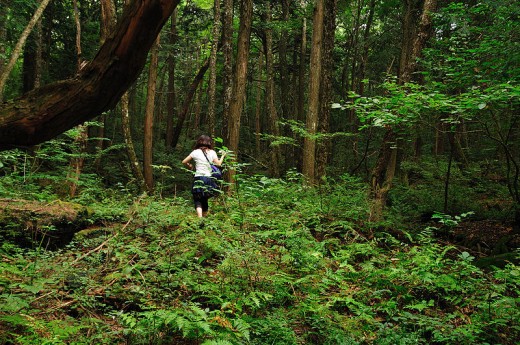 Japan’s sacred Aokigahara Forest Japan’s sacred Aokigahara Forest
.
Ethics question for Yoshio Haga (President of Nippon Paper Group):
What moral right do the Japanese have to consider their own native old growth Aokigahara Forest more sacred than Australia’s sacred native old growth forests such as those across East Gippland?
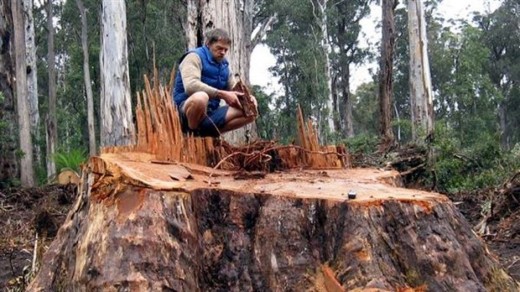 Stump of Brown Mountain’s sacred 600 year old Mountain Ash old growth tree.
It was logged by VicForests in November 2008 for Nippon Paper’s Reflex Paper. Stump of Brown Mountain’s sacred 600 year old Mountain Ash old growth tree.
It was logged by VicForests in November 2008 for Nippon Paper’s Reflex Paper.
.
.
In light of VicForests recent civil prosecution in the Victorian Supreme Court, Nippon Paper Group’s association with VicForests calls into question the reputation of Nippon Paper Group and its brand Reflex Paper:
.
‘VicForests has been stopped from harvesting certain coupes in the Brown Mountain forest in East Gippsland containing old growth forest
– habitat for rare and threatened species – until the completion of steps implementing the precautionary principle.’
.
.
.
‘Environment East Gippsland Inc v VicForests – The precautionary principle in action’
22 November 2010:
[Source: Blake Dawson (Lawyers), ‘Environment Matters’, 20111122, ^http://www.blakedawson.com/Templates/Publications/x_article_content_page.aspx?id=60457, accessed 20110825]
.
.
In Brief:.
- ‘The Victorian Supreme Court decision in Environment East Gippsland Inc v VicForests firmly embeds the approach to the precautionary principle laid down in Telstra Corporation Limited v Hornsby Shire Council (2006).’
- ‘The case makes it clear that the precautionary principle can be the subject of an enforceable obligation.’
- ‘The case also makes it clear that the precautionary principle applies both at the strategic and operational stages of a project or undertaking.’
- ‘The fact that VicForests complied with its forestry approvals was not enough to satisfy the Court that it had met its obligations with regard to the precautionary principle.’
.
‘In Environment East Gippsland Inc v VicForests [2010] VSC 335 conservation group Environment East Gippsland (EEG) won a landmark injunction against VicForests, a state-owned timber business with responsibility for commercial timber harvesting in Victoria’s state forests.
VicForests has been stopped from harvesting certain coupes in the Brown Mountain forest in East Gippsland containing old growth forest – habitat for rare and threatened species – until the completion of steps implementing the precautionary principle.
In this case, Justice Osborn of the Supreme Court of Victoria undertook a thorough analysis of the application of the precautionary principle in the context of a detailed legislative regime aimed at balancing biodiversity protection and commercial timber harvesting. The case embeds the approach to the precautionary principle laid down by Chief Justice Preston of the Land and Environment Court of New South Wales, in Telstra Corporation Limited v Hornsby Shire Council (2006) 67 NSWLR 256.’
.
The lead-up to the litigation
.
‘The Brown Mountain forests in Victoria’s East Gippsland contain old growth forests and provide habitat for rare and threatened species such as the Powerful Owl, the Spotted-tailed Quoll (mainland Australia’s largest marsupial carnivore) and the Long-footed Potoroo. However, these areas are also amongst the most productive timber harvesting forests in Victoria and play a crucial role in Victoria’s sustainable timber industry.
In 2006, the Victorian State Government committed to increasing the conservation parks and reserves within the broader Brown Mountain area. Nevertheless, in 2008 commercial logging in the Brown Mountain area began.
After numerous studies of the area indicated the presence of important threatened and rare species, EEG requested the Minister for Environment and Climate Change, Gavin Jennings, to make an interim conservation order to conserve critical habitat of the endangered Long-footed Potoroo, Spot-tailed Quoll, Sooty Owl, Powerful Owl and Orbost Spiny Crayfish at Brown Mountain. The Minister did not grant a conservation order, but instead increased the conservation area surrounding Brown Mountain.
Having failed to obtain undertakings from VicForests that it would not proceed to log the Brown Mountain coupes, EEG sought interlocutory injunctive relief. An interlocutory injunction restraining logging was granted by Justice Forrest on 14 September 2009 (see our article Environmental litigation heats up with some significant wins for public interest litigants in our 2 October 2010 edition of Environment Matters ), pending the outcome of the full proceedings before Justice Osborn in the Supreme Court of Victoria.’
.
The legislative regime
.
‘Logging of state forests in Victoria is regulated by a complex scheme of legislation, codes of practice, management plans and procedures, described by Osborn J as “labyrinthine”. The principal legislation includes the Forests Act 1958 (Vic) (Forests Act), Sustainable Forests (Timber) Act 2004 (Vic) (SFT Act), Flora and Fauna Guarantee Act 1988 (Vic) and Conservation, Forests and Lands Act 1987 (Vic).’
.
Responsibilities for timber harvesting and forestry management
.
‘VicForests is a state-owned corporation, established in 2004 to undertake the harvesting of timber in Victoria’s state forests. The Secretary to the Department of Sustainability and Environment (DSE) has overarching responsibility for managing state forests and timber harvesting within forests under the Forests Act.’
.
Legal challenge
.
‘EEG sought an injunction restraining VicForests from harvesting four coupes at Brown Mountain containing old growth forest. It also sought declarations that timber harvesting within the coupes by VicForests in accordance with the current forestry regime would be unlawful.
EEG argued that the current conservation measures for the Brown Mountain coupes did not meet the requirements of the regulatory system, which addresses the preservation of conservation values and in particular the protection of endangered species. EEG also argued that VicForests had failed to implement the precautionary principle.
VicForests took issue with EEG’s standing to sue. Further, it denied the presence of a number of endangered species and argued that the logging of the Brown Mountain coupes would take place under a legislative framework that adequately protects endangered species and would, therefore, be lawful. It also argued that it was DSE’s responsibility to stipulate any further requirements for habitat protection in accordance with the regulatory regime.’
.
EEG’s standing
.
‘Following the settled High Court authority that standing to bring such proceedings depends on the plaintiff’s “special interest” in the subject matter of the litigation (Australian Conservation Foundation v Commonwealth (2000) 200 CLR 591), Osborn J was satisfied that EEG had a relevant “special interest” because:
- EEG uses the coupes to a greater degree than the general public (for example, the group has a “Valley of the Giants Old Growth Forests Walk” through the affected coupes);
- EEG’s predecessor was involved in the consultative process for the formulation of the applicable forest management plan; and
- the government has previously recognised EEG’s status as a body representing this sector of the public interest.’
.
The precautionary principle [Ed: once again]
.
‘The VicForests case firmly embeds in Australian environmental jurisprudence the approach to the precautionary principle laid down by Chief Justice Preston of the Land and Environment Court of New South Wales, in Telstra Corporation Limited v Hornsby Shire Council (2006) 67 NSWLR 256 (Telstra). Justice Osborn’s decision in VicForests is the first Supreme Court application of the Telstra principles.
The precautionary principle is integrated throughout the Victorian forestry regime’s many instruments.
Following Preston CJ’s two-fold test in Telstra, Osborn J stressed that the precautionary principle is a test of common sense. There must be:
- a threat of serious or irreversible environmental damage; and
- scientific uncertainty as to the environmental damage.
Justice Osborn stated:
Once both of these conditions or thresholds are satisfied, a precautionary measure may be taken to avert the anticipated threat of environmental damage, but it should be proportionate … [The] degree of precaution appropriate will depend on the combined effect of the seriousness of the threat and the degree of uncertainty.
It is a “wherever practicable” test.
In practice, this meant that once the two-fold test was satisfied by EEG, VicForests had the onus of proving that the threat posed by logging the coupes did not exist or was negligible. Because it could not do this, the question then became:
- whether the threat was able to be addressed by adaptive management measures (in this case the requirement for surveys and management zone reviews); and
- whether the measure alleged to be required (here the permanent injunction against logging the coupes) was proportionate to the threat in issue.
Justice Osborn carefully examined the legislative regime and held that it is not intended that VicForests only apply the precautionary principle at the strategic planning stage:
VicForests is specifically required to apply it [the precautionary principle] having regard to the results of monitoring and research as they come to light during operations. … The requirements of the precautionary principle fall to be considered in the light of the whole of the evidence bearing on these matters as it now is and not as it was at the time VicForests completed planning.
Justice Osborn stressed, however, that the precautionary principle sits within a wider statutory regime that takes into account principles of sustainable development.
He held that unless VicForests complied with the requirements of the applicable Flora and Fauna Guarantee Act Statements and with conditions stated in the relevant allocation order (under the Forests Act) and the Timber Release Plan (under the SFT Act), logging at Brown Mountain would be unlawful.
This meant that VicForests could not rely on its current approvals to log the coupes because DSE had not, for example, changed zonings in the coupes to reflect the presence of threatened species. VicForests had an ongoing, active duty to apply the precautionary principle, which included responding to new information as it became available.
Importantly, Osborn J stressed that the precautionary principle can be the subject of an enforceable obligation.’
.
Outcome
.
‘Justice Osborn ordered that VicForests stop harvesting until various measures had been completed to respond to the detection of endangered species and to implement a precautionary approach with respect to their potential extinction. The required measures included:
- creating or amending special management zones, special protection zones and retained habitat areas to protect the Long-footed Potoroo, Greater Gliders and Yellow-bellied Gliders (as relevant);
- undertaking further surveys for the Giant Burrowing Frog, Large Brown Tree Frog and Spotted-tailed Quoll; and
- completing a current review of the Powerful Owl and Sooty Owl Management Areas,
to the satisfaction of the Director, Biodiversity Policy and Programs, DSE.
The difficulty for the Court in formulating its orders was that the power to act on the evidence of rare and endangered species and implement the required legislative and policy changes lies not with VicForests, against whom the injunction was sought, but with DSE.
Justice Osborn overcame this difficulty by stopping VicForests from logging until certain actions are undertaken, these actions being DSE responsibilities. VicForests had maintained throughout proceedings that it would comply with any changes to the regulatory regime made by DSE, and this was accepted by the Court.
.
Significance of the decision
.
This case firmly embeds the approach to the precautionary principle laid down by Chief Justice Preston in Telstra Corporation Limited v Hornsby Shire Council (2006) 67 NSWLR 256.
Justice Osborn’s decision makes it clear that:
- The precautionary principle can be the subject of an enforceable obligation.
- Parties having an obligation to apply the precautionary principle cannot demonstrate compliance with the principle solely through departmental approval of their actions or relevant approvals under the regulatory regime; the precautionary principle is an active obligation that applies throughout operations, requiring parties to respond to new information as it arises.
- The precautionary principle applies throughout all stages of operation, not just the strategic planning (or approvals) stage.
The decision has broader implications because:
- The precautionary principle is embedded in many other statutory regimes in Victoria and around Australia, apart from the Victorian legislative regime for forestry and the protection of endangered species. The decision has implications for any statutory regime in which the principle is enshrined.
- Although VicForest is a state-owned enterprise operating within a highly regulated environment, there is scope for the decision to be applied to other types of entities operating within industries where the precautionary principle is relevant.
Furthermore, a decision of the Supreme Court of Victoria has strong precedent value, and is likely to be adopted by the Supreme Courts of other States, and perhaps even higher courts or courts with federal jurisdiction.
.
Action points
.
Parties under an obligation to apply the precautionary principle need to be aware that:
- to implement the precautionary principle as per the principles laid down in Telstra, parties need to ask:
- is there a real threat of serious or irreversible damage to the environment?
- if yes, is it attended by a lack of full scientific certainty (in the sense of material uncertainty)?
- if yes, is the threat non-existent or negligible?
- if no, is the threat able to be addressed by adaptive management and is the measure alleged to be required proportionate to the threat in issue?
- the principle must be applied at both the strategic decision making stage of a project, and throughout the operational stage; and
- it may not be sufficient to simply obtain and comply with project approvals – parties need to proactively respond to new information as it arises throughout the operational stage.’
.
..
.
Further Reading:
.
[1] >Vicforests’ Ecological Genocide
.
[2] ‘Nippon buys Maryvale mill‘, by Ian McIlwraith, The Age newspaper, 20090217, ^http://www.theage.com.au/business/nippon-buys-maryvale-mill-20090216-89bu.html, accessed 20110826]
.
‘Paperlinx will take a $600 million hit on its half year results and the future of its Tasmanian operations is under review after last night unveiling the partial sale of its Australian papermaking business.
Japan’s Nippon Paper Group will buy most of Australian Paper, which includes the Maryvale pulp mill in Gippsland, for more than $700 million, including taking on attached debt and a three-year profit share agreement.
Money from the sale, expected to be completed in June, will go to reducing PaperlinX’s debt burden to about $340 million…’
[Editor: So Paperlinx was in debt to the Australian Tax Office by over a billion dollars? How can Australia’s pulp industry be profitable then?]
.
[3] Australian Paper Watch website (providing information about the logging of Victoria’s forests to make paper products such as Reflex by Nippon Paper and their ‘subsidiary’ Australian Paper), ^http://www.australianpaper.forests.org.au/
.
[4] Nippon Paper’s Maryvale Mill Upgrade, ^http://www.reflex.com.au/2008-Maryvale-Mill-Upgrade/
‘Australian Paper has a long history in the La Trobe Valley in Gippsland, Victoria, dating back to 1937 when established. Today, the Mill is Australia’s largest integrated pulp and paper operation. In response to global paper trends and changing consumer expectations for our products, Australian Paper (Nippon Paper subsidiary) embarked on a major upgrade of the Maryvale Pulp Mill in 2006 which was completed in December 2008. With an investment of $350 million, the upgrade significantly expanded the Mill’s production of bleached pulp capacity and delivered a range of safety, health and environmental benefits.’
.
[5] ‘Loggers, activists clash over forest‘, by Adam Morton, The Age newspaper, 20110817, August 17, 2011, ^http://www.theage.com.au/victoria/loggers-activists-clash-over-forest-20110816-1iwew.html
.
‘Conservationists have held up timber workers in a fiercely contested area of native forest on Melbourne’s fringe for nearly a month, chaining themselves to bulldozers and climbing trees scheduled for logging.
The protest, which has led to at least 10 arrests, is expected to reach a climax today as activists and local residents march into the logging coupe outside Toolangi in Victoria’s central highlands.
Protest organisers claim they have evidence the coupe is home to the endangered Leadbeaters Possum, which scientists say is under threat after Black Saturday bushfires wiped out up to half its habitat. But the Department of Sustainability and Environment says there has been no sign of live possums. Department spokeswoman Kim Payne said one tree in the coupe had hollows that showed evidence of possum use. That tree would be left standing, but the coupe did not meet the legal criteria of prime possum habitat and could otherwise be logged.
Sarah Rees, director of Healesville-based group My Environment, said it was cruel to think a possum could be protected by retaining a single tree while taking away the forest around it. She said logging was hurting central highlands communities.
.
”Tourism based on the state forest is far more important to the local economy than forestry and the two cannot co-exist,” she said.
The conflict over the Toolangi State Forest was the focus of a public meeting in the area late last week when logging opponents verbally clashed with forestry workers, who accused the activists of restraint of trade. One contractor said he had lost about $80,000 due to the protests.
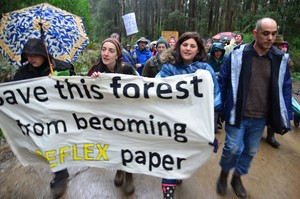
David Walsh, spokesman for state commercial timber agency VicForests, said the Toolangi protests had cost forest workers significant time. Only about a quarter of the 19-hectare coupe had been harvested. He said gates raised to ensure public safety had been damaged. ”VicForests believes these are legal harvesting operations which comply with the detailed legislative framework governing native timber harvesting in Victoria,” he said.‘
.
Editor: The legal doctrine of ‘restraint of trade’ sought to be applied in the commercial exploitation and destruction of old growth forests, is an invalid excuse. It is a contemptible euphemism for a ‘right to rape’ old growth ecology that is being contrived by commercial lawyers profiting from the exploiters ~ a case of the morally bankrupt collaborating with the damned.
[6] Ethical Paper website, ^http://www.ethicalpaper.com.au/
.
[7] My Environment website, ^http://www.myenvironment.net.au/
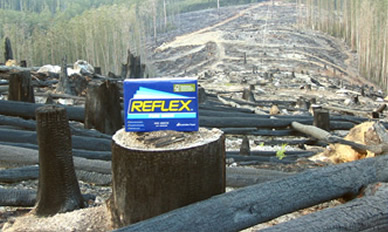
.
– end of article –
Tags: Aokigahara Forest, Atsuta Jinja, Australian Forestry Standard, Australian Paper, Chain of Custody certification, deforestation, East Gippsland, EEG, endangered species habitat, Environment East Gippsland, Environment East Gippsland Inc v VicForests, Flora and Fauna Guarantee Act, Forest Stewardship Council, Forestry Standard Certification, FSC, FSC audit process, FSC Chain of Custody Certification, FSC International, FSC-C002059, Future Fibre Strategy, Giant Burrowing Frog, Greater Glider, Greenwash Tick, Kashima Jingu, Kasuga Taisha, Kirishima Jingu, Large Brown Tree Frog, Leadbeaters Possum, Logging, Long-footed Potoroo, Maryvale Pulp Mil, My Environment, Nippon Paper Group, PEFC, Powerful Owl, precautionary principle, pulp and paper, Rainforest Alliance, Reflex Paper, restraint of trade, right to rape, sacred forest, Shimogamo Jinja, Shinto religion, Sooty Owl, The Wilderness Society, Timber Release Plan, Toolangi State Forest, TWS, VicForests, Yahiko Jinja, Yellow-bellied Glider
Posted in Gippsland (AU), Owls, Potoroos, Quolls, Reptiles, Threats from Deforestation | No Comments »
Add this post to Del.icio.us - Digg
Friday, August 19th, 2011
(The following article was initially posted on CanDoBetter.net by Tigerquoll on 20090426. It has since been modified.)
.
 VicForests’ neo-colonial practice of logging old growth East Gippsland forests, justifies such culling by claiming compliance with Australia’s wood production Standard AS 4708-2007. But this standard is Mein Kampf for ecological genocide of East Gippsland Forests. VicForests’ neo-colonial practice of logging old growth East Gippsland forests, justifies such culling by claiming compliance with Australia’s wood production Standard AS 4708-2007. But this standard is Mein Kampf for ecological genocide of East Gippsland Forests.
Have a read: http://www.forestrystandard.org.au/files/Standards/4708.pdf [Read the Standard]
Under this official Australian Standard that sees only the wood for the trees, it includes two criteria that serve to deliver propaganda spin respect for forest ecology. One must recognise these criteria accompanying Criterion 4—Forest management shall maintain the productive capacity of forests. Need I say more?
Forestry Propaganda Criterion #3 for instance, requires forest management to ‘protect and maintain the biological diversity of forests’. Wonderful wholesome, noble and holistic rumblings about this one – but gullibles wake! VicForests <em>Mein Kampf</em> hides the ‘ chainsaw-speak‘ in the detail:
* ‘Small-scale clearing is permitted up to a limit of 40 hectares on a single forest management unit’. ‘Conservation of threatened (including vulnerable, rare or endangered) species and ecological communities requires the forest manager to minimise adverse impacts by ensuring he/she takes into account of known information and relevant specialist advice‘. (Makes Fiji look like a democracy!)
Forestry Propaganda Criterion 5 requires forest management to maintain forest ecosystem health and vitality, yet is so vague as to allow forest ‘practices’ only to ensure that damage stays “within tolerable levels”. Does this mean one tree per hectare can be left standing or may be two?
.
Then there’s Clause 4.5.3:
‘Forest managers managing native forests shall use fire and other disturbance regimes to maintain and enhance forest ecosystem health where appropriate to the forest type or scale.’ [p.25]
.
…that is, burn and disturb native forests at will, because we argue that doing so enhances forest ecosystem health. Whoops! The wind picked up and the forest is gone; still we complied with AS 4708-2007!
Such contemptible logic would argue that a bushfire raging through a town can to it good, because eventually the town is rebuilt and the people eventually return, look at Narbethong!
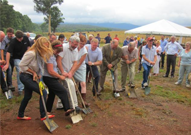
.
.
The Ferguson Tree – lest we forget
.
“The tallest tree ever properly measured was a Eucalyptus tree and was 436 feet tall. It was measured by William Ferguson on the 21st of February in 1872. Alarmingly the crown was broken off when the tree was still 1 meter thick, leading to claims that it once was up to five-hundred feet tall in one point in its lifetime.”
The length was a staggering (if true) 133 metres (436 feet) with its crown (the tree’s top) broken off!! The stump’s diameter five feet off the ground was 5.5m (18 feet) and at its broken top its diameter was still 1 metre. It is estimated that had this tree actually still been intact it would have approached 152m (500 feet) in height. The surveyor also noted numerous fallen trees in the same area over 106m (350feet) in height.
It would have been a Mountain Ash or Eucalyptus regnans. Sorry, no photo available. The legend remains only in text.
[Source: ^http://jtpredwoods12345.blogspot.com/]
.
.
‘VicForests accused of felling old-growth mountain ash’
.
[Source: Adam Morton, 20100629, The Age newspaper, ^http://www.theage.com.au/victoria/vicforests-accused-of-felling-oldgrowth-mountain-ash-20100628-zf5o.html]
.
‘The Victorian government’s forestry arm will face a legal challenge over claims it illegally logged old-growth forest and increased the risk to a threatened species.
Environmental groups accuse VicForests of felling dozens of pre-1900 ash eucalypts, breaching the Central Highlands Forest Management Plan. An impending legal case will also claim the timber agency failed to protect habitats necessary for the survival of Victoria’s threatened faunal emblem, Leadbeater’s possum.
Ecologist Jacques Cop, from consultants Acacia Environmental Group, said a survey of just one coupe near Toolangi found 31 pre-1900 ash eucalypts had been logged. Five stumps were more three metres across.
”These are trees that are 200 or 300 years old,” he said.
Mr Cop said the area should also have been protected as a Leadbeater’s possum habitat as it met the threshold of having at least 12 hollowed trees within three hectares. He said neither the state Department of Sustainability and Environment nor VicForests carried out ground surveys to check if ecological requirements were being met. Sarah Rees, president of local group My Environment, said the situation was an emergency.
’31 pre-1900 ash eucalypts had been logged’
.
“If this doesn’t stop we’re going to lose the last viable habitat for a range of different species, but Leadbeater’s possum carries the strongest case for legal protection“, she said.
The state government said it took the allegations “extremely seriously“.
Spokesman Michael Sinclair said VicForests would investigate the alleged breaches and report to the Department of Sustainability and Environment. VicForests spokesman David Walsh said the agency carried out detail planning before harvesting to ensure it acted within the law and had offered to meet local residents to better understand their concerns.
“No old-growth forest is harvested by VicForests in Victoria’s central highlands region”, he said.
The legal case, being prepared on behalf of a group called the Flora and Fauna Research Collective, comes amid community concern about the scale of logging in the central highlands after the Black Saturday bushfires.
The Wilderness Society said that evidence supporting the latest claims showed illegal logging of native forests was rife under the state government’s watch.
A separate allegation of illegal logging at Brown Mountain, in east Gippsland, is the subject of a pending Supreme Court judgment.
“Premier Brumby must act now to end VicForests’ woodchip rampage in Victoria’s magnificent native forests“, said Wilderness Society spokesman Luke Chamberlain.

Sarah Rees at the base of an ancient mountain ash spared the chainsaw but killed during a clean-up fire near Toolangi.
She says the present situation is an emergency.
Photo: John Woudstra
.
.
 VicForests motto reads: “Victorian Timber: beautiful, natural, functional” VicForests motto reads: “Victorian Timber: beautiful, natural, functional”
[SOURCE: http://www.vicforests.com.au/]
.
..in lay terms, this means kill beautiful natural specimens – they make the finest woodchips for reliable REFLEX office paper.
.
.
VICFORESTS: “VicForests employs over 140 staff across 10 Victorian sites located in Melbourne, Healesville and regional areas of Central Highlands and East Gippsland.
We have a variety of exciting career opportunities available – our Foresters specialise in tactical and operational planning, roading, harvesting and contract management, silviculture and native forest regeneration.
Other career paths include customer management, resource and business analysts, safety and risk, operational audit, forest scientists and product delivery.”
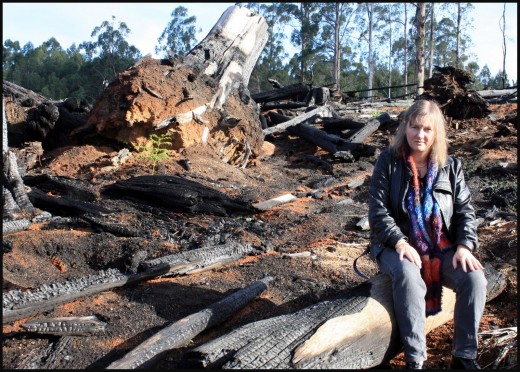
VICFORESTS: “We also employ staff in non-forestry roles including IT, HR, communications, finance, administration and customer service. A significant proportion of our staff and contractors are also involved with fire-fighting efforts each year.
VicForests is focused on investing in its employees through training, development, and providing career opportunities.”
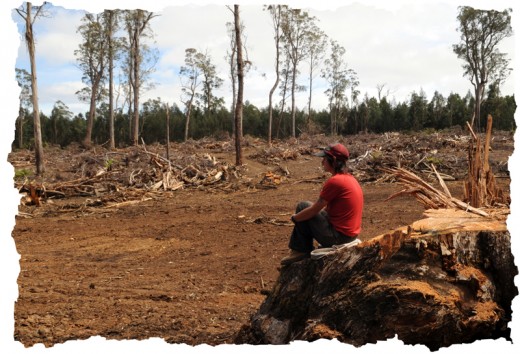
VICFORESTS: “We look for dynamic people who have a strong desire to be part of an organisation that strives to achieve success through implementing excellent and innovative business and timber industry practices for our customers and stakeholders.
Contributing to the timber industry is something that VicForests and its staff are proud of.”
.
[Source: ^http://vicforests.logic1.com.au/employment.htm, accessed 20110819]
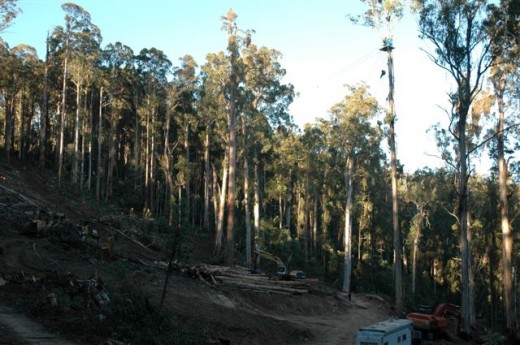 Vicforests’ coup at Stoney Creek
East Gippsland 2009 Vicforests’ coup at Stoney Creek
East Gippsland 2009
.
.
‘VicForests’ 2009 Annual Report reveals $5.1 million loss’
.
‘VicForests’ 2009 Annual Report has once again revealed that the logging agency continues to waste taxpayer millions of dollars sending our forests to the woodchip mills. The report shows that VicForests has posted a loss this year of $5.1 million. This is on top of last year posting a tiny profit after receiving a $5 million lifeline from government, and a loss the previous year.
 Woodchip train makes its way to Midways, Geelong (2009) for as little as $2.50 per tonne.
Photo: Wilderness Society Collection
Woodchip train makes its way to Midways, Geelong (2009) for as little as $2.50 per tonne.
Photo: Wilderness Society Collection
.
‘Whilst VicForests squanders Victorian taxpayer’s hard earned money, woodchipping and paper companies continue to post handsome profits. Whilst we don’t yet know how much they will make for 2009, South East Fibre Exports, a wholly owned subsidiary of Japanese paper giant, Nippon Paper, last year made over $10 million profit. They woodchipped approximately half a million tonnes of Victoria’s native forests, and this year paid as little as $2.50 per tonne for them.
Another giant company, Australian Paper, which makes Reflex papers, is VicForests’ largest single customer and was recently purchased for around $700 million by Nippon Paper. The $5.1 million loss is on top of an extra $1.3 million handout for bushfire recovery and does not include the massive $29 million royalty that it has failed to hand over to the state government who, along with the Victorian public, own these forests.’
.
[Source: ^http://www.wilderness.org.au/campaigns/forests/vicforests-2009-annual-report-reveals-5.1-million-loss]
 A tombstone of the once impenetrable forest.
A Mountain Ash stump alongside an old forestry track in Balnook, Gippsland.
Note the notches cut in the trunk for standing planks to cut the tree down by axe!
A tombstone of the once impenetrable forest.
A Mountain Ash stump alongside an old forestry track in Balnook, Gippsland.
Note the notches cut in the trunk for standing planks to cut the tree down by axe!
.
.
Reflex Office Paper
‘Paperlinx’s giant Maryvale mill located in Victoria’s Central Highlands is the largest pulp and paper making complex in Australia, consuming 475,000 cubic metres of eucalyptus forest per annum (RFA, 1998).
‘In July 2006, the Maryvale Mill received Forest Stewardship Council (FSC) Chain of Custody Certification for A4 Reflex products manufactured on its Number 3 and Number 5 Paper Machines. Paperlinx has been proudly promoting its environmental credentials ever since (as well as before).
Paperlinx is Australia’s only office paper producer. Its flagship product REFLEX copypaper is 100 per cent virgin native forest. Woodchips to make the paper are sourced from areas including rainforest, old growth forest, endangered species habitat and Melbourne’s largest water source, the Thompson Dam catchment area. Woodchips are also sourced from the Strzelecki Rainforest Reserve, an area that was promised protection by the state government due to its high conservation value.
These areas can be visited and viewed first hand, or determined by satelite image maps which show different forest types (such as rainforest as compared to woodlands) and where logging is occuring. The fact that Paperlinx gained FSC accreditation has raised concerns amoung environment groups who have been campaigning for the protection of these areas for over a decade.
Reflex Recycled Paper
Paperlinx has recently released a brand of paper wrapped in green packaging labelled Recycled. Fifty percent of REFLEX Recycled paper is made from pre-consumer waste (printers’ offcuts), but no genuine post-consumer (eg kerbside collected) recycled papers. The other fifty percent is from the same virgin native forest as stated above.
According to The Wilderness Society Paperlinx has the resources and technology to make use of alternative sources such as plantations and recycled paper, but doesn’t do so as it receives state-owned native forest logs for a significantly lower cost than plantation logs.
Due to the lack of accurate information reaching the public, an alliance of Australia’s peak environment groups including The Wilderness Society, Environment Victoria, Friends of the Earth and the Australian Conservation Foundation released a flier in 2004 urging people to boycott REFLEX paper and listing alternatives.
THE ALTERNATIVE
There is no 100 per cent recycled office paper manufactured in Australia. Brands made overseas that are available in Australia include Evolve, Canon 100 and Fuji Xerox Recycled Supreme.’
[Source: ‘Reflex Office Paper‘, Greenwash .org ^http://www.greenwashreport.org/node/41 ]
.
‘Always rely on Reflex to woodchip old growth‘
  Scott Gentle from the Victorian Forest Contractors Association
questions the logic of the Yarra Ranges council’s decision to boycott Reflex paper products.
[Source: ^http://free-press-leader.whereilive.com.au/news/story/paper-ban-anger/] Scott Gentle from the Victorian Forest Contractors Association
questions the logic of the Yarra Ranges council’s decision to boycott Reflex paper products.
[Source: ^http://free-press-leader.whereilive.com.au/news/story/paper-ban-anger/]
.
.
Further Reading:
.
[1] ‘Brown Mountain Rape’, ^http://candobetter.net/node/1005
[2] Ethical Paper, ^http://www.ethicalpaper.com.au/
[3] Save Sylvia Creek Toolangi, ^http://www.myenvironment.net.au/index.php/me/Community/SAVE-Sylvia-Creek-Toolangi
[4] Brown Mountain – final court orders, ^http://www.eastgippsland.net.au/?q=campaigns/brown_mountain/whats_new
[5] Reflex Office Paper, ^http://www.greenwashreport.org/node/41
[6] Victorian Supreme Court Decision: ‘Environment East Gippsland Inc v VicForests [2010] VSC 335 (11 August 2010)’, ^http://www.austlii.edu.au/au/cases/vic/VSC/2010/335.html
.
.
– end of article –
Tags: Acacia Environmental Group, Australian Paper, Brown Mountain, chainsaw-speak, East Gippsland logging, ecological genocide, Ferguson Tree, Forestry Standard 4708, Forestry Standard Certification, Gippsland Giants, illegal logging, Leadbeater’s possum, Logging, Nippon Paper Group, Reflex Paper, Toolangi, VicForests
Posted in Gippsland (AU), Possums and Gliders, Threats from Deforestation | No Comments »
Add this post to Del.icio.us - Digg
Thursday, August 18th, 2011
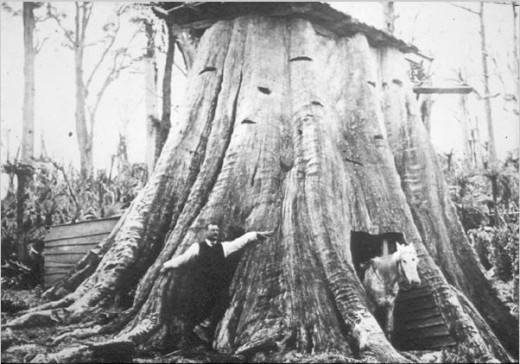
Gippsland Giants
by John Stephens
.
‘Do you know that possibly the biggest living thing in the world once lived in Gippsland and that its descendents still live here? No it’s not the blue whale, nor the giant kangaroo or the thylacine or even the black panther, it’s Eycalyptus regnans, the Victorian or Mountain Ash! These trees are the world’s tallest hardwoods and the tallest flowering plants.
The trees in the Tara Bulga Park are certainly imposing and of an impressive size, somewhere in the vicinity of sixty metres tall! You’ve seen Mountain Ash on drives or walks throughout the Strzelecki Ranges or the Baw Baw plateau. But I’m sorry to tell you, that you haven’t seen a real Mountain Ash and are most unlikely to ever see one. Of course I am talking about specimens that did exist before we “harvested” them. I don’t consider myself a “greenie” however I cannot be anything but amazed at the destructiveness of the human species.
During my “younger days” I spent many an enjoyable hour riding a motorcycle around the top end of Merriman and Traralgon Creeks. One of my greatest memories was seeing the stumps of some huge trees that had been logged, somewhere on the western side of the Merriman Creek headwaters, and imagining what they must have looked like in their original grandeur. I also came across the huge “historic” tree stumps at Mt Tassie and as many others have, I marvelled at their massive girth.
The Ada Tree near Powelltown, which is estimated to have existed for over three hundred years, is possibly the largest remaining specimen in Victoria. It has been preserved and is estimated to stand at about 76 metres, although it was significantly taller. The crown has been blown away either in a storm or struck by lightning, meaning the tree may have reached a height in the vicinity of 120 metres. Another giant, The Big Tree, in the Cumberland Tall Trees Reserve is 82 metres tall, but was 92 metres before a storm destroyed the top in 1959. What stuns me, is that if I imagine one of these trees to be the imposing Eucalyptus obliqua in the top corner of my block and it fell along the fence line, it would stretch the full 83 metres of the block!
“The Baron” height – 66m, girth 14.5m
 |
Near Narbethong – 91m, girth 7.7m
 |
I understand that to our pioneers the supply of forest, trees and timber seemed endless and they had a need to provide land for agriculture and development. However I do not understand their need to destroy everything that they saw as a challenge. Why did they have to destroy the Centennial Exhibition Tree that had stood in the Menzies Creek forest for hundreds of years until its demise in 1888? It was measured at over 122 metres after being felled and was reassembled for display at the exhibition in Melbourne. Surely it would have been better to take parties to visit the living tree in its natural surrounds and glory.
Part of an article written by Paul Edwards cleverly conveys what most of us feel about these giants – “When a tree gets old and tumbles, it becomes a noble thing — a fallen tree — but when it is cut down it turns into a log”. The best way to measure a tree is of course to do so when it has been cut down. This is essentially what happened to another giant at Thorpdale. It was felled in the1880s, measured by the surveyor G Cornthwaite, and found to have been 114.3 metres tall. I believe all that remains to signify the existence of this giant is a sign on the roadside indicating where it once stood, definitely far less impressive than the tree itself.
Some of these old trees must have been even more impressive. A 66 metre tall tree in Sassafras Gully in the Dandenongs and known as “The Baron” had a girth of 14.5 metres. The Bulga Stump, which was destroyed in the 1939 bushfires, famous for its huge girth of 34 metres! The Furmstons or Mueller Tree near Mt Monda was only 60 metres high when it fell in 1998 although it was estimated to be well over 100 metres when it was first discovered in the late nineteenth century. Another giant was a hollow stump in the Tarra Bulga area that had a roof and was used as a stable. The hollow Wonga Stump near Yarram was used as a church and a school until it was destroyed by fire in 1898.
The tallest known existing tree in the world is now a Californian Redwood (Sequoia semprivirens) found in the Humbolt Redwood State Park. It is 112.7 metres in height but is “small” compared to the tallest ever recorded, an American Douglas fir (Pseudotsuga menziesii) which was known to be 122 metres, equal to our Centennial Tree. However do these trees really compare to our own? A tree at Mt Baw Baw measured in 1889 by surveyor G W Robinson was reported to be 143 metres in height.
In 1872 the Victorian Government surveyor, William Ferguson, reported finding a fallen tree in the Healesville area that was 133 metres long. The top had been broken off in the fall and most of the crown burnt in a fire. Where it was broken the tree was approximately one metre in diameter and was estimated therefore to have been 152 metres tall!
Were there bigger specimens or are there still giants in the Gippsland forests? Maybe there was a tree of such dimensions that if in my imagination it fell the length of my block it would also complete the side boundary of the property behind mine.
[Source: ^ http://home.vicnet.net.au/~apslvg/gippslandGiants.html]
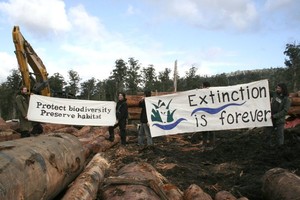
Title of this article is derived from two well known sayings:
- ‘Forgive them, for they know not what they do.’ Source: The Bible: ‘And Jesus said, “Father, forgive them, for they know not what they do.” And they cast lots to divide his garments.’
[© English Standard Version, Luke (23:34) 2001)]. These are supposedly Jesus’ words from the cross, asking forgiveness for those who put him to death. More widely, of course, the plea was for all humanity. [Rare historic photos of these magnificent trees are all that allow us to remember what once was. The saying is quite apt to old-growth trees, though I have removed the ‘Father, forgive them‘ clause.]
- ‘Lest we forget‘ Source: Rudyard Kipling’s poem of 1897, ‘Recessional’, which he composed on the occasion of Queen Victoria’s Diamond Jubilee in 1897. The poem, on the one hand, expresses pride in the British Empire, but, on the other, expresses an underlying sadness that the Empire might go the way of all previous empires. [Again, quite apt to old-growth trees.]
.
‘God of our fathers, known of old—
Lord of our far-flung battle line—
Beneath whose awful hand we hold
Dominion over palm and pine—
Lord God of Hosts, be with us yet,
Lest we forget—lest we forget!
The tumult and the shouting dies—
The Captains and the Kings depart—
Still stands Thine ancient sacrifice,
An humble and a contrite heart.
Lord God of Hosts, be with us yet,
Lest we forget—lest we forget!
Far-called our navies melt away—
On dune and headland sinks the fire—
Lo, all our pomp of yesterday
Is one with Nineveh and Tyre!
Judge of the Nations, spare us yet,
Lest we forget—lest we forget!
If, drunk with sight of power, we loose
Wild tongues that have not Thee in awe—
Such boastings as the Gentiles use,
Or lesser breeds without the Law—
Lord God of Hosts, be with us yet,
Lest we forget—lest we forget!
For heathen heart that puts her trust
In reeking tube and iron shard—
All valiant dust that builds on dust,
And guarding calls not Thee to guard.
For frantic boast and foolish word,
Thy Mercy on Thy People, Lord!
Amen.
.
– end of article –
Tags: Centennial Exhibition Tree, Dandenongs, Eucalyptus regnans, Gippsland, Gippsland Giants, Logging, Menzies Creek, Mountain Ash, Mt Baw Baw, Mueller Tree, old growth, The Baron, The Big Tree, The Bulga Stump, Thorpdale, world's largest trees
Posted in Gippsland (AU), Threats from Deforestation | No Comments »
Add this post to Del.icio.us - Digg
Wednesday, July 20th, 2011
The following article was initially posted by Tigerquoll on 20090326 on CanDoBetter.net:
.
On Thursday 26th March 2009, four people were charged in their efforts to save East Gippsland old growth forests at Upper Delegate River from being chopped down.
 ‘The Goongerah Blockade’ ‘The Goongerah Blockade’
Protesting against logging of old growth forests in East Gippsland
….prepared to be arrested for habitat.
March 2009.
eco-warriors all!
.
Conservationists trying to conserve protected old growth forests have been charged with illegal conservation. Is Victorian Premier Brumby’s strongman stance seeking to emulate Mugabean democracy?
Is Brumby’s hypocritical law for conservationists that of prima facie guilt of conservation? Surely the need to conserve rare and remnant old growth forests makes conservation self-evident?
Premier Brumby’s DSE and VicForests under their own laws maintain these catchment forests under environmental protection legislation. Yet in breach of their own laws, Brumby’s environmental watchdogs have become lapdogs, watching loggers irreparably destroy these centuries-old Eucalypts and lay witness to Victoria’s disappearing natural heritage. It’s no different to Indonesia condoning destruction of Sumatran and Kalimantan rainforests.
When was the last time Brumby bushwalked through old growth Gippsland? Last year, or never?
A dedicated group of 20 forest conservationists prevented clearfelling in the upper Delegate River catchment up until now. “This particular old growth forest was recently surveyed by trained biologists and the result showed very high density of tree dwelling mammals”, said spokesperson for the group Carmel Roberts.
“The DSE is neglecting their responsibilities to protect endangered wildlife habitat, even though it clearly states in their Forest Management Plan that where high numbers of threatened species are found, habitat must be protected.
“The DSE are saying they are unable to protect these species’ habitat despite the logging being in clear breach of their legal obligations. The government puts more value on a months work by a few people than protecting endangered wildlife from extinction.
“In 2006, Premier Brumby made an election promise to protect the “last significant stands of old growth”. These forests are the very the last refuges for our rare species.”
“Since the devastation caused by the bushfires, East Gippsland’s forests are now even more critical to the survival of Victoria’s native species than before. Rare native wildlife could have been made locally extinct in other areas due to the fire damage.”
“Old growth forest habitats such as hollow-bearing trees, are critically important for the survival of these threatened species in Victoria. The logging industry can survive in plantations and regrowth, endangered wildlife can’t.”
.
.
Comments:
.
Woodchip mafia has Brumby well trained
March 28th, 2009 by ‘Blackdog’:
.
The Brumby government is truly the lapdog to the loggers. The woodchip mafia has him well trained. The rule book says the threatened species have to be saved. He destroys them and their habitat. The promise back in 2006 was to save the old growth – but all he’s done is cover for the increased targeting of prime areas.
Yep – no different to Indonesia or the Amazon. Only Brumby employs better media spin experts. Pity the public don’t wear it.
.
.
Lap dog governments are following Easter Island
On March 28th, 2009 Tigerquoll says:
Blackdog’s comments hit the mark.
I go further than black dog.
Lap dog governments are supporting destructionist loggers while publicly advocating environmental protection in another department.
This is gross hypocracy, a conflict of interest and corrupt.
I worry also that as more clever HSC graduates take on degrees in ‘communications’, which so frequently entices them into well paid jobs in government and corporate spin machines, that pure ethics is neglected at both senior school and at most university courses.
By denying our children skills and wisdom in worldly ethics, our children are being denied their rights to cope with ethical decisions. A degree without a base in ethics is a degree in propaganda, and don’t our lapdog governments lap them up?
Take the following example and ask why in our education system and supposed independent journalism, that Australians are more aware of the extremely rich celebrities than the natural and indigenous exploitation and neglect condoned by governmenst in Australia’s World region?
SOURCE: www.drmartinwilliams.com/conservation-and-environment/indonesian-forest-destruction-corruption-plays-a-role.html
“Since 1982, forest fires on a large scale in Kalimantan, Sumatra and Java have come with the onset of each dry season. A fire in Kalimantan in 1983, reportedly the largest in human history, destroyed 3.7 million hectares of rainforest, an area the size of the Netherlands.
In 1987, 2 million hectares, 1.4 million of primary rainforest, were destroyed in Kalimantan, Sumatra, East Timor, Sulawesi and mountain regions of Java.
In 1991 smoke and ash from fires blanketed Singapore, Malaysia and the Straits of Malacca, forcing Indonesia to call for international help.
Forest fires of this magnitude coincide with a rapid increase in logging and plantation activities which began in the early 1980s. In 1966, 82% of Indonesia’s land mass was covered by primary forest. By 1982 this had shrunk to 68%, and recent satellite photographs indicate that forest cover – including timber plantations – is now down to about 55%.
In late 1996, the Indonesian minister of forests said that 20 million hectares of forest were in a critical state and warned that this was increasing rapidly. The World Bank estimates 800,000 hectares of forest are lost each year.
Around 64 million hectares – one-third of Indonesia’s land mass – is devoted to commercial logging. In 1996 Indonesia became the world’s largest plywood exporter.
…
On September 9, Suharto reissued a 1995 ban on burning forest and called on the military to help enforce it. Companies were given until October 3 to prove they were not the culprits.
Laws allow up to 10 years’ imprisonment and a 100 million rupiah fine for polluters. Not one company, however, has ever been convicted. Even the environment minister, Sarwono Kusumaatmadja, admitted to Reuters on September 22 that environmental laws are not policed properly.
Soon after Suharto’s announcement, the number of fires increased, as companies rushed to clear as much land as possible before the deadline. Even if the deadline was strictly adhered to, it would only let companies finish clearing land at a time the normal rainy season would have forced them to do so.
…
But it is not just the greed of Suharto and the logging and plantation firms which has created this disaster.
Government investment and development policies which have promoted destructive land clearing practices are spurred on by market forces and capitalism’s endless drive for profit. Many of the projects were championed by and funded by institutions such as the World Bank and the IMF, which pressure countries such as Indonesia to increase exports.”
In 2009, we must learn from Easter Island’s ancient community and its unsustainable culture of nature exploitation which ended up condemning its civilization to extinction. Else, despite our iPods, in 2009 we risk the same fate.
.
.
Injustice rules the forests
March 30th, 2009 by Sheila Newman:
.
About time this shameful situation got coverage. I would like to see a story for EVERY charge against conservationists on candobetter.
It is quite true, as you say, that the Victorian Government frequently breaks the law in its forest activities. In fact it has practically torn up its own rule book.
Keep fighting!
.
– end of article –
Tags: Carmel Roberts, clear felling, conservationists charged, East Gippsland, Goongerah Blockade, John Brumby, Logging, old growth forests, Premier Brumby, tigerquoll, Upper Delegate River, VicForests, woodchip
Posted in Gippsland (AU), Threats from Deforestation | No Comments »
Add this post to Del.icio.us - Digg
Tuesday, March 30th, 2010
by Editor 2010330.
The New South Wales government logging agency, euphemistically named ‘Forests NSW’, has ongoing plans to log old growth native forests through the South East Corner bioregion of NSW. These forests provide rare and important habitat for Australian fauna, some of which in this region are now critically threatened with extinction due to the logging, burning and deforesting activities of Forests NSW, the National Parks Service under its parent which changes its name every frew years, and the NSW Rural Fire Service.
Australia’s SE Corner (SEC) Bioregion encompasses the shires of Eurobodalla, Bega Valley, Bombala and parts of Cooma-Monaro and Snowy River. The South East Corner forests include the Tilba, Bermagui, Murrah, Mumbulla, Tanja and Wapengo State Forests . It also includes a number of national parks including the Biamanga National Park.
Not surprisingly, many Australians, and particularly locals in this bioregion, value these forests being protected and are opposed to the habitat destruction being wrought to the old growth forests. Key active environmental organisations seeking to protect these forests include the Friends for Five Forests and the South East Region Conservation Alliance Inc. (SERCA). SERCA is an umbrella organisation for conservation, environment and for citizens’ groups who want to conserve and protect the natural environment of South East NSW, Australia. SERCA’s member organisations include Bega Environment Network | Chipstop | The Coastwatchers Association Inc | Colong Foundation for Wilderness | Friends of Durras | National Parks Association – Far South Coast | Natural Native Forests | SE Forest Rescue | Yurangalo Inc.
SERCA formed in September 2005 to ’maximise efforts and resources’ of these organisations to combat the continued NSW Government-sanctioned woodchipping of native forests, to participate in formal environmental planning by the NSW Government in the regionprocesses and importantly to protect these forest habitats from damaging development and land and forest management practices.
Below is a series of reports on the events affecting these forests from these various organisations and from media reports up until March 2010.
Forests NSW have moved into log the Mumbulla State Forest
SOURCE: Friends for Five Forests, 20100329, http://www.fiveforests.net/
29 March 2010:
‘Forests NSW have moved into Compartments 2133 and 2135 in Mumbulla State Forest.
‘After a local resident photographed koala prints on Lizard road, near Cpt 2163 next on the logging list, the DECCW have apparently decided to undertake surveys before their burning operation on the other side of the road.
‘Much of the forest in Mumbulla creek catchment of Biamanga NP is growing on the Murrah soil landscape – still the only place koalas have been located. On this basis and in combination with the State Government’s management, the species remains endangered and likely to become extinct.’
Tanja State Forest – local residents meeting with State Forest reps.
Richard Blakers, 20100322 http://www.serca-online.org/our_media_releases/2010/Blakers22.rtf
22 March 2010:
‘Residents shocked by scale of proposed logging in Tanja State Forest Local residents met with State Forest representatives last week to discuss proposed logging operations in Tanja State Forests.’
‘The residents thanked the State Forests representatives for meeting with them and listened carefully to the information they provided. However, residents are very unhappy with the outcome of the meeting. They were shocked to discover the scale and intensity of the proposed logging and are not satisfied with State Forest responses to any of the concerns raised.’
‘The areas to be logged lie between Bega and Tathra along the north side of the Bega River. Near Mogareeka, the logging comes to within 50 metres of the river. It is also along the eastern side of ReedySwamp Road and extending along all the ridges and down to within 15 -20 metres of the drainage lines and creeks draining into the Bega River.’
‘The State Forests representatives explained steps taken to protect water quality, wildlife and scenic values in the logging operations. However it was clear that the measures are the barest minimum and worked out to allow for maximum tree removal, not maximum protection of other forest values.’
‘State Forests representatives conceded that after the proposed logging operation all available larger trees will have been removed from the forest and it will be well over 100 years before similar trees will again be available for commercial logging.’
‘They also stated that the logging was being driven by their need to meet wood supply agreements, and that within 3-5 years this kind of logging would stop in the Southern Region Forests because the supply of older trees will be exhausted. Once this happened, the industry would restructure to be able to use smaller trees.’
‘State Forests acknowledged that this logging will have significant short and long term impacts on local residents, and suggested the solution might be for residents to question their decision to buy property adjoining state forest.’
‘Residents think this is not a helpful attitude that does not address any of their issues.’
‘The residents have legitimate concerns about what happening to the public forests around our towns and homes. State Forests representatives do not seem to be in any position to cater to the residents needs because they are under pressure to meet wood supply agreements.’
‘Residents are therefore demanding that the State Government bring forward plans to restructure the timber industry and place a moratorium on logging in these coastal forests. It is not reasonable that these areas of older forest that have significant values other than just timber production should be sacrificed in order to meet such short term
goals.’
Koala colony under threat
Source: ABC 7pm TV News NSW, 18 March 2010, http://www.abc.net.au/news/video/2010/03/18/2849958.htm
‘Environmental groups say State Government plans to commence logging in the Bega Valley, on the NSW far south coast, will decimate the local koala population.The last known population of koalas on NSW’s far south coast could be under threat by State Government plans to log their habitat.’
Forests NSW & RFS burn 700 ha of Biamanga NP
SOURCE: Friends for Five Forests, 20100329, http://www.fiveforests.net/
Early March 2010:
‘Working collaboratively the NPWS, Forests NSW and the Rural Fire Service [RFS] have decided to burn close to seven hundred hectares of Biamanga National Park.
‘It appears the timing of this operation is consistent with plans to begin unsustainable logging on Monday 29 March. Consequently the NPWS is proposing to close the Lizard road to reduce access to the logging area from the east.’
NSW Government report on koalas in Mumbulla State Forest is flawed
SOURCE: Friends for Five Forests, 201002, http://www.fiveforests.net/
February 2010:
‘The month ends with NSW government releasing a belated ‘interim’ report on the highly inefficient and non-adaptive/heuristic koala surveys. Amongst other disturbing elements the survey took 5 times as long to complete as the pilot survey. The cost to date, leaving aside the eight arrests and other time runs at over $1million, being twice the estimated value of all the sawlogs remaining in Mumbulla State Forest.’
‘The survey outcome, based on employing a 2% (?!) activity contour, is that less than 5% (1089 ha) of the area surveyed (22,000 ha) is said to be occupied by koalas. Regrettably there is some uncertainty about how this area has been derived as the RGB-SAT methodology measure for a single tree in a plot is 3.3%. There are no details as to how the 2% contour has been calculated although theoretically it should encompass a greater area than a 3.3% contour but this is apparently not the case.’
‘Seems to be another example of how the NSW and other governments put unsustainable logging above all else. On a positive note the genetic analysis demonstrates the NSW Scientific Committee was quite wrong.’
Loggers are set to destroy one of Australia’s last remaining koala habitats.
Source: John Hibberd, SERCA: http://www.serca-online.org/our_media_releases/sercamembers/Koala.pdf
February 2010:
‘The NSW Government has started sending contractors into the forests in South Eastern NSW. Negotiations between the NSW Department of Environment and the state government agency responsible for logging, Forests NSW, appear to have failed to reach a compromise.
‘The irony is that the NSW Government last year ordered a survey to try and find koalas in the coastal forests that are now about to be logged. The survey, which was conducted across all land tenures, found a small, active population of about 30 koalas and is continuing.
‘It seems the NSW Government has now decided its contractual obligations to supply saw logs locally and woodchips to Asia are more important then protecting this much loved native animal, which is immortalized in Australian culture.
‘The disease, Chlamydia, plus loss of habitat have contributed to a dramatic decline in koala numbers over recent decades, with the species now close to being declared endangered.
“Soon it will be too late to save the species.” Says Debora Numbers of koalas in Australia may be as low as 45,000 recent surveys by the Australian Koala Foundation show.
‘The koala population in South Eastern NSW was once healthy but in the last 100 years has been decimated by hunters interested in koala pelts and by logging.
‘Forests NSW have not publically given a date for the start of logging in the Mumbulla State Forest, no doubt expecting direct action from conservationists who forced loggers out of an area close by three years ago.
‘The issue will put heat on the new premier of the state of NSW, American-born Kristina Keneally, who was installed by the right-wing faction of the party recently.
‘And Commonwealth Minister for the Environment Peter Garrett – a former rock star with internationally successful band Midnight Oil and environmentalist – has been asked to intervene.
‘Steve Phillips – arguably NSW most experienced and expert Koala scientist, said on ABC radio recently,” We have got the management prescriptions (for koalas) wrong, especially in the SE …. The small area of koala habitat remaining is such a precious resource …. They have just got to be protected so they can continue to expand ….. there is no longer any argument about what is important habitat”.
‘NSW Minister for forestry Ian MacDonald stated in Parliament in 2008 that despite recurrent financial losses, logging in native forests will continue, in order to support jobs.
‘Yet billions of dollars of taxpayer funds have been pumped into plantations as replacement timber and fiber for industry and export. NSW Forests rely heavily on the outdated Regional Forest Agreements that were signed off in the late 90s giving new areas in National Parks to the state but retaining forests for logging. Conservationists say the industry is outdated and only propped up by political will and union backing.
‘These agreements are excluded from the Environment Protection Act (EPBC) as well as climate change and water supplies.
‘Will zoos soon be the only places to see koala? Will NSW Premier Kristine Keneally do her part and stop logging these coastal forests of Mumbulla, sealing the fate of these last few koala?’
‘It seems not despite 2010 being The Year of Biodiversity.’
Logging Plan Poses Threat to Precious Koala Colony
SOURCE: Friends for Five Forests, 20100124, http://www.fiveforests.net/ from Sydney Morning Herald.
January 2010:
‘The year begins with the NSW government deciding to support the (Japanese) native forest logging industry and their proposals to eliminate the last koalas. According to the Sydney Morning Herald: Forests NSW and the Department of Environment and Climate Change are “ . . . in search of a compromise between felling trees and maintaining enough forest to allow the koalas to survive.” (http://www.smh.com.au/environment/conservation/logging-plan-poses-threat-to-precious-koala-colony-20100124-msm7.html)
‘Referring to the Regional Forest Agreements the recently released independent review of the EPBC Act states “ . . . if the terms of the approval are not complied with, or if there is insufficient reporting information to verify that compliance, Dr Hawke recommends that the approval should be terminated.” And “ . . . the full protections of the Act should apply to forest activities.” In his press release Environment Minister Peter Garret stated:
“ . . . the Government notes the concerns raised by Dr Hawke in recommendation 38 in the review regarding the current mechanisms in the Act for forest management under Regional Forest Agreements (RFAs), and is committed to working with state governments to improve the review, audit and monitoring arrangements for RFAs, including their timely completion, clearer assessment of performance against environmental and sustainable forestry outcomes, and a greater focus on compliance of RFAs in the intervening years.”
‘The Government intends to use upcoming RFA renewal processes to improve the achievement of these outcomes in future RFAs. In light of this, the Government rejects the mechanisms proposed in recommendation 38 and does not propose to review section 38 of the EPBC Act as it currently applies to RFAs.” [Source: http://www.environment.gov.au/minister/garrett/2009/mr20091221.html]
The fact that the DECC are working with Forests NSW to ensure logging in the catchments suggests that they either remain unconvinced that logging spreads Bell-miners or they believe that koalas like sick trees. If the Commonwealth are committed to these ideas they should have no problems working with the state government.’
Forests NSW ignores koalas to permit logging of Mumbulla State Forest
SOURCE: Friends for Five Forests, 20100329, http://www.fiveforests.net/
December 2009:
‘With no apparent reason, other than to progress koala extinction the NSW Government is reportedly planning business as usual when work resumes in the New Year. This work has begun and the Department of the Environment for Climate Change (DECC) has deleted from their website all information about the koala surveys over the past 2 years.’
‘The NPWS Regional manager Tim Shepard is reported as saying “. . . now we have a good idea of where Koalas live . .” We are using this information to help us plan our hazard reduction programs”(Coastal Custodians, Nov/Dec 2009). Also, a rumour has spread from the Wapengo Watershed Association claiming Forests NSW will begin the year logging koala habitat in Mumbulla State Forest. While the source of this proposal remains unconfirmed, it does confirm some suspicions. Notably that logging is to be suspended at Bermagui so the negative impacts of uncontrollable wildfire in logging slash adjacent to the town, can be reduced over summer. Killing koalas is, apparently, OK.’
Logging begins in Compartment 2001 in Bermagui State Forest
SOURCE: Friends for Five Forests, 20100329, http://www.fiveforests.net/
‘Forests NSW have approved logging in 89% of the compartment as opposed to the maximum of 60% allowed for in their legal approvals. Desperate to maintain timber supplies this logging confirms the statement from Forests NSW manager Mr Martin Linehan that “We can do what we want when we want“.
‘Fifteen months after the NSW Government released a map that is inconsistent with the outcomes of the pilot koala surveys. Koala expert Dr Steve Phillips has been interviewed ABC local radio about the uncertain fate for koalas at a national level and the last few Five Forests koalas.’
Forests NSW Illegally Logging in Bermagui
SOURCE: Friends for Five Forests, 20100329, http://www.fiveforests.net/
September 2009:
‘Four arrests have been made as a result of Forests NSW claims, but examination of the operational map, the prohibited area notice and the logging plan(s) for Cpt 2002 demonstrate the logging is outside the IFOA. Critical koala habitat is being destroyed while the NSW police support Forests NSW illegal logging.’
‘Logging began in Compartment 2002 of Bermagui State Forest on Thursday September 10. The logging plans (download from resources page) for the compartment are not an accurate or honest representation of soil, flora, water or roads in the compartment. Details of concerns about the operations, also available on the resources page, have been passed onto the NSW police and NCS International.
‘Forests NSW can log this critical koala habitat on the only soil landscape known to have koalas because they have been able to abuse the process based on unproven claims about koalas in the south east.’
‘A community conducted review of the Eden Regional Forest Agreement (RFA) between the Commonwealth and NSW State Governments has found that forests in the southeast are being exploited at rate that far exceeds the limits of ecological sustainability and those of the relevant legislation.’
‘Community representative on the Forest Resources and Management Systems Committee for the Eden assessment process and review author Mr Robert Bertram believes that the RFA has failed to achieve the legislated ecological milestones and this failure has negative implications at local, regional and global levels.’
“ The review analyses Annual reports from the NSW Forestry Commission that indicate dramatically reduced timber yields of 60% for sawlogs and 40% for pulp logs and a massive escalation in areas being logged, such that over the past five years nearly 50% of all State forests in the Eden region have been scheduled for logging.’
“These outcomes confirm that extensive canopy dieback and the associated death of millions of trees in the southeast is having a significant impact on the native forest logging industry. It is apparent that some 50,000 hectares of additional forests have been covertly handed over to ensure wood supplies.’
“These additional forests include areas that the Forestry Commission failed to declare during the Eden assessment and vast tracts of forests on the tablelands, that have similarly not been assessed. It is apparent that these Crown forests are being logged with the assistance of significant public subsidies and at a rate that greatly exceeds the requirements of the RFA.
However, of greatest concern is that the RFAs are designed to ignore the science that explains the decline of eucalyptus forests and it’s relationship to timber supplies, species extinction, catchment degradation and climate change. It seems that Government departments and other publicly funded organizations are either threatened or ‘paid off’ to ignore or suppress relevant information. The success of the RFA has been to demonstrate that ignorance and greed has overcome credible science, accountability and intergenerational equity.”
‘The review entitled: ‘The effects of deforestation on timber volumes, areas logged and associated climate change issues: A community review of the EdenRegionalForest Agreement” can be downloaded at the Friends of the Five Forests website: http://www.fiveforests.net/resources
Forests NSW has compartment 2002 in the Bermagui State Forest on its worklist
SOURCE: Friends for Five Forests, 2005, http://www.fiveforests.net/
‘Friends of Five Forests and their supporters will have to mount yet another campaign to have the logging stopped if Black Lagoon and Meads Bay are to be protected in accordance with the sanctuary zone classification they have been given as part of the Batemans Marine Park, and if the very few remaining koalas are to have any chance of survival. This large compartment of predominantly spotted gums is a significant part of the catchment for Narira Creek and Black Lagoon, which link into Meads Bay.’
‘The Batemans Marine Park provides for the highest level of protection of Black Lagoon and Meads Bay as sanctuary Zones. Logging can be expected to lead to further serious siltation of the Creek, and to damage plant and fish life in both the Lagoon and Meads Bay. The Park Zone Plan does not come into operation until June 2007.’
‘Pre-emptive action by Forests NSW to log compartment 2002 in the interim would make a mockery of the Marine Park zoning.’
‘The compartment contains areas of significant koala habitat. It is also next to part of the Kooraban National Park that contains the only koalas in this immediate region. Both this area and compartment 2002 are occupied by the Five Forests koala population, which was nominated as endangered some years ago.’
‘NSW Government release of a report by consultants on a Koala Management Plan for the region is now well overdue.’
‘Friends of Five Forests and their supporters will have to mount yet another campaign to have the logging stopped if Black Lagoon and Meads Bay are to be protected in accordance with the sanctuary zone classification they have been given as part of the Batemans Marine Park, and if the very few remaining koalas are to have any chance of survival.’
150 residents call for immediate halt to all logging operations in the Five Forests
SOURCE: Friends for Five Forests, 20050320, http://www.fiveforests.net/
20 March 2005:
‘More than 150 people from many areas of the Bega Valley Shire and beyond attended a meeting at the Murrah Hall to hear about logging operations being implemented by non-adaptive land managers in the coastal forests around Bermagui.’
‘The meeting was unanimous in calling for an immediate halt to all logging operations in the Five Forests.’
‘In late May 2005 the NSW Forestry Commission breached the conditions of the Regional Forest Agreements and their Threatened Species licence when they started to log critical Koala habitat in Cuttagee catchment part of Murrah State Forest.
‘As a result of community actions the logging crew pulled the operation four days after it started and after FNSW arrested two people.’
‘Several actions are being planned and implemented that are aimed at stopping the further destruction of our flora, fauna and degradation coastal catchments and implementing sustainable forest management.’
The second stage has been the production of management and research proposals that take a holistic approach to natural resource management. The management and research proposals blend appropriate restoration forestry with world’s best practise and public accountability.’
As a result of the communities efforts and after failing to find anyone in DEC prepared to accept the mission, the NSW State Government has recently employed consultants to gather community opinions for possible input into a Koala Management Framework.’
[Background Ecology] ‘Koalas in the Bega Valley’
SOURCE: John Hiberd, SERCA, 201002, http://www.serca-online.org/latest_news/koala.pdf
‘There were once, 100 years ago, hundreds of thousands of koalas in the Bega Valley. They were so numerous that you could even see them in the trees along Bega’s main street! Hunting for the fur trade, habitat loss through extensive clearing, and fire have all decimated that once vast population.
Now all we know for sure is that a tiny remnant clings on in Mumbulla State Forest, with a few scattered individuals possibly elsewhere. And this is what they
are going to log and burn. Recent DECCW surveys have shown that this population is slowly recovering, and may now number up to 50 individuals. Studies of tree species preferred by Mumbulla koalas have shown that species diversity appears to be important for them.’
‘Surprisingly, given this population’s small size, DNA analysis by Sydney University has shown that Mumbulla koalas are genetically strong, and thus potentially able to increase their numbers without some of the inbreeding problems that have affected other disjunct koala populations.
Koalas need space. They need space to find the most nutrient rich leaves for their highly specialised diet; they need space so that young males, forced from their homes, can find new territories; they need space to handle our changing climate with more frequent and longer droughts; and they need space if their population is going to grow to a more viable size, capable of withstanding major events such as fire or disease.’
‘It is this space that they are being denied. And for what? For the sake of a few months supply of sawlogs and woodchips. Once they have logged and burnt, we may have prolonged the inevitable decline of the local sawlog industry, but we will have lost our koalas for ever!’
‘It is also no good just thinking that we can log carefully. The requirements of koalas are so poorly understood as to make it impossible to be certain which trees they are going to need, or in which direction they are going to need to move. Perhaps forestry believe that they can get away with just “not logging the trees with koalas in them”! And once the forest has been logged it will be burnt, which will nicely finish off any remaining koalas!’
‘The koalas of the Far South Coast are an integral component of our natural heritage – a natural heritage which has endured for millenia – respected by the traditional Aboriginal custodians of the land – a heritage which has led to the designation of this area as Australia’s Coastal Wilderness, with a campaign aimed at increasing tourism in the area and thus improving the local economy. Yet again we face the dilemma of short-term economic gain versus long-term
environmental degradation and the loss of opportunity to establish a truly sustainable local economy.’
‘A Koala recovery programme in these coastal forests has the potential to become an internationally recognised species recovery project, since:
-
They are an iconic species facing regional extinction, but for which there appears to be a reasonable chance of recovery with appropriate management actions;
-
There is a significant role for indigenous people, both because they are custodians of the area (especially the adjacent Biamanga National Park), and because of potential training and employment opportunities that could arise through the recovery program;
-
We now have a sound scientifically-based foundation giving us the capacity to monitor the conservation status of the population;
-
There are a range of educational and research outreach opportunities involving tertiary institutions, schools and field studies centres;
-
We can build a significant role for the local community; and,
-
We can develop substantial opportunities for research-based tourism and thus grow the local economy in a sustainable manner.
© The Habitat Advocate Public Domain
Tags: Bermagui State Forest, Biamanga National Park, Forests NSW, Koala, Logging, Mumbulla, Murrah, SE Corner Forests, SERCA, South East Region Conservation Alliance, Tanja, Tilba, Wapengo
Posted in Koalas, South East Corner (AU), Threats from Bushfire, Threats from Deforestation | No Comments »
Add this post to Del.icio.us - Digg
Tuesday, March 16th, 2010
Victorian Government’s VicForests is attempting to log old growth forests at Brown Mountain in East Gippsland, despite Brown Mountain being confirmed habitat for threatened and vulnerable wildlife. Local not-for-profit environment group Environment East Gippsland has commenced proceedings against VicForests in the Supreme Court of Victoria asking the Court for a permanent injunction to stop VicForests from logging Brown Mountain.
.
Reports:
(most recent at top)
‘The Brown Mountain landmark trial has concluded in the Supreme Court on Thursday 25th March – after a 16 day trial.’
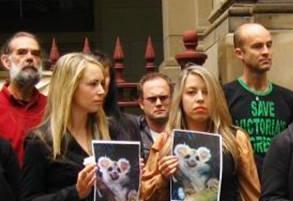
© Environment East Gippsland 2010 ^ http://www.eastgippsland.net.au/
East Gippsland residents outside Victorian State Parliament in early 2010
protesting against the Victorian Government’s immoral and illegal logging and scorched earthing
of old growth forests of Brown Mountain in East Gippsland Victoria, Australia.
.
The photos show a Greater Glider [Petauroides volans]. The Greater Glider is strictly nocturnal, and largely solitary, arboreal species of undisturbed eucalypt-dominated woodland habitats. It is endemic to south eastern Australian forests including Brown Mountain and its population is decreasing largely due to land clearing for agriculture, logging, and bushfires.
[Source: Environment East Gippsland, 20100327, ^http://www.eastgippsland.net.au/]
.
‘Justice Osborn has reserved his decision. It could take anywhere from one month to six months to hand down a finding, but of course we are hoping sooner.
The four week trial has been marked by finger-pointing between government logging bodies VicForests and DSE about who is responsible for endangered species. The behavior of those charged with protecting our wildlife has been exposed to public scrutiny and the Supreme Court’s enquiry.
We believe the government doesn’t survey for endangered wildlife before they log old growth forest, because they don’t want to find anything that would prevent logging. The Court heard that VicForests doesn’t employ wildlife experts, and EEG has argued that both VicForests and the DSE sideline the opinion of the government’s biodiversity unit. We now hope the Minister is fully informed about the very high conservation values in this area.
EEG presented evidence of a new species of crayfish in Brown Mountain Creek, plus experts claiming the stands of old growth are high quality habitat for two species of rare frogs, and the Spotted-tailed Quoll. The evidence for the Spotted-tailed Quoll was heart-breaking – the three last remaining viable colonies are in East Gippsland.
This case has been all about whether irreversible damage would be caused by logging. And as our legal team stated:
“You can’t get damage that is more irreversible than extinction.”
The outcome of this case is important for the protection of wildlife in other stands of high conservation value native forests under threat of clearfelling.’
.
.
‘The Brown Mountain landmark trial has begun!’
[Source: Environment East Gippsland, 20100315, ^ http://www.eastgippsland.net.au/]
.
‘After months of preparation, our legal team and supporters have gathered in Sale and begun the two-week Brown Mountain landmark trial.
Everything is going very well so far. It’s difficult to report on a hearing that is in progress, particularly since we are the plaintiff, so this article might lack a few things.
Our lead barrister, Debbie Mortimer SC, spent Monday afternoon and Tuesday morning in Court outlining what we say are the facts and the law, in a fascinating opening submission.
She spoke about the beautiful native wildlife that is central to our case, and the Court was treated to large pictures of the critters. It was almost surreal, but quite appropriate in our view, to see a team of lawyers in black gowns and wigs defending the furry, the feathered, the cray and the frog.
She said that VicForests has a number of legal responsibilities towards the environment, including endangered species, and that those responsibilities are inconsistent with logging at Brown Mountain.
For a more detailed summary of the first day’s hearing, read this excellent article by The Age journalist Kate Hagen, who is attending the hearing Click here Journalists from ABC Radio and Win TV (channel 9) are also attending the hearings.
VicForests’ lead barrister Ian Waller SC started outlining VicForests’ case this afternoon. When Court adjourned today, he said he still had about an hour to go, so we haven’t got the full picture yet.
But generally speaking he contended that VicForests’ responsibility to the environment wasn’t anywhere near as strong as we made out, and was balanced by its requirement to create economic and social benefits. He said that, to the extent to which VicForests has responsibilities to the environment and native wildlife, it has fulfilled them.
Today (Wednesday), Justice Osborn and the legal teams are having a look at Brown Mountain first hand. It’s not just a bushwalk, though; they will observe first hand some places and concepts about forests, logging and post-logging practices that will later on be discussed in Court.
On Thursday morning, VicForests’ opening submissions will finish, then Environment East Gippsland will bring out our witnesses.’
.
Fate of native Forest Hangs on ‘David v Goliath’ Court Case
Source: Environment East Gippsland, (EEG), 20100301, ^http://www.eastgippsland.net.au/
.
Environment East Gippsland Inc (EEG) v Vic Forests Brown Mountain Court Case, Sale, Monday, March 1
‘The fate of a native forest with trees dating back to Joan of Arc’s time is at stake in a Supreme Court case to be heard at the Victorian centre of Sale from Monday (March 1).
‘The landmark Brown Mountain case has national implications for all native forests in Australia and major political implications, with the green vote likely to be vital for both State and Federal Labor Governments in an election year – which is also the UN’s Year of Biodiversity.
‘In a David and Goliath battle, Environment East Gippsland (EEG) is seeking to stop state-owned logging monopoly VicForests from clear-felling Brown Mountain, a rich and ancient forest which is “chockablock” with threatened and endangered species.
‘The action marks the first time a Victorian court has been asked to grant a permanent injunction against state-sanctioned logging. It will also raise the fundamental conflict in Australia’s Regional Forest Agreement – where the State Government charged with protecting the forests is also the logger.
‘That was underlined in Victoria last year when Environment Minister Gavin Jennings gave the go-ahead to logging at Brown Mountain, declaring there were no threatened species in there. That very morning an EEG camera captured footage at Brown Mountain of a Long-footed Potoroo, one of Victoria’s most endangered species.
‘In the absence of government protection, EEG was forced to take legal action to defend the forest – an enormous and costly step for a community group.
‘In an Australian first, EEG last year won a temporary injunction on logging at Brown Mountain, ahead of the full hearing, with Supreme Court Justice Forrest comparing images from the forest to the WW1 battlefields of the Somme. But even if successful with their action, conservationists anticipate the Victorian Government may favour the logging industry and over-ride the court’s decision as has happened in previous high-profile cases in both Victoria and Tasmania.’
.
.
Brown Mountain Background
Source: Environment East Gippsland ^http://www.eastgippsland.net.au/
.
‘Brown Mountain, in East Gippsland in Victoria, contains old growth forest with ancient trees, one carbon-dated to 600 years old. It is prime habitat for threatened species including the Long-footed Potoroo, Spot-tailed Quoll, Sooty Owl, the Large Brown Tree Frog, the Square-tailed Kite, and the Giant Burrowing Frog. It is also a hotspot for arboreal mammals, like the Greater Glider and the Yellow-bellied glider.
‘Environment East Gippsland (EEG) alleges that logging four coupes on Brown Mountain is unlawful because it breaches provisions to protect endangered and threatened species in the Victorian Sustainable Forests (Timber) Act 2004 and the Flora and Fauna Guarantee Act 1988. In particular EEG says that VicForests has failed to comply with the Code of Practice for Timber Production 2007.
‘In the 2006 election, the Bracks Labor Government promised to protect “the last significant stands of old growth currently available for logging”. Brown Mountain should clearly have been included but, instead, 20 hectares were logged in summer 2008-09. Threatened species surveys triggered a moratorium in February 2009 followed by more surveys over winter and spring and, in August 2009, an EEG survey camera recorded the presence of a Long-footed Potoroo, one of Victoria’s most endangered species, despite the government’s declaration – earlier that same day- that there were NO threatened species at Brown Mountain.
‘In September 2009, EEG successfully obtained an interim injunction against VicForests to prevent logging in the coupes. In granting the injunction, Justice Forrest likened photographs of logging to ‘pictures of the battlefields of the Somme’.
‘Already the case has delivered important precedents:
- The Supreme Court refused VicForests’ application for up to $163,000 in security from EEG before a court injunction was granted to stop logging on Brown Mountain. Having to pay such a large sum would have stopped the community group being able to challenge critical habitat logging.
- The interim injunction, granted late last year, was also a groundbreaking decision because no Victorian court has ever ordered an injunction on logging before.
‘However there are concerns that the Victorian Government could override a logging ban, if the EEG case is successful.
‘Greens Leader Bob Brown successfully brought a court case to halt logging at the Wielangta forest in Tasmania because it threatened the endangered Swift Parrot, Tasmanian Wedge-tailed Eagle and Wielangta Stag Beetle. Then Prime Minister John Howard and Tasmanian Premier Paul Lennon amended the Regional Forest Agreement to permit logging to continue.
‘In 1998, logging at Goolengook in far eastern Victoria, the site of Australia’s longest running forest blockade from 1997 to 2002, was found to be unlawful because it was within a protected area next to a Heritage River. The Victorian government changed the law retrospectively to make the logging legal.’
.
.
Member’s Statement: VicForests – Brown Mountain old growth forest
SOURCE: Victorian Greens, 20090402, ^http://mps.vic.greens.org.au/node/1057
.
‘Ms PENNICUIK (Southern Metropolitan) — The Waikato Radiocarbon Dating Laboratory at the University of Waikato in New Zealand has confirmed that a tree cut down by VicForests in the Brown Mountain old-growth forest was between 550 and 600 years old. Until now foresters have claimed that these large trees were between 200 and 250 years old. Others have assumed that between 300 and 400 years would be the age limit before the trees succumb to rot. The tree was young when Joan of Arc lived and Christopher Columbus discovered America. It measured 11 metres around the stump close to the ground. Other trees on Brown Mountain have girths of 12 metres and more and could between 700 and 800 years old. They would have been mature when Marco Polo travelled the world. These trees are ancient relics and part of our precious national heritage.
‘VicForests and the Brumby government cannot replace these trees once they are cut down. They are logged on a 50-to-80-year rotation. It would take until 2600 AD for a tree to grow to the same size.
In 2006 Premier Brumby promised to protect the last significant stands of old-growth forests. Since then hundreds of hectares of these ancient forests have been cut down. It is not good enough for the government to claim that VicForests is independent and that the government can do nothing to save Brown Mountain. The government must act now to protect all remaining old growth forests in East Gippsland.’
.
.
Brown Mountain to stay green – for now
SOURCE: The Wilderness Society, http://www.wilderness.org.au/campaigns/forests/brown-mountain-to-stay-green-2013-for-now
.
‘Brown Mountain, in Victoria’s East Gippsland, is home to magnificent old-growth trees as well as endangered species like the Orbost spiny crayfish and the Long-footed potoroo. ‘One of the giant Brown Mountain trees that will hopefully be saved by the Supreme Court Injunction.
(Photo: Luke Chamberlain)
‘One of the giant Brown Mountain trees that will hopefully be saved by the Supreme Court Injunction.
(Photo: Luke Chamberlain)
.
‘But despite previous promises from the Victorian government to protect the last significant stands of old-growth forests in the state, Brown Mountain still has no protection against logging by VicForests.
‘Early in 2009, things were looking dire. Ignoring community outrage, VicForests’ bulldozers continued to destroy trees as old as 500 years.
‘Supported by the Wilderness Society, along with many concerned residents, volunteers and other concerned Victorians, Environment East Gippsland brought a last-minute court injunction against the logging at Brown Mountain.
‘Environment East Gippsland is Victoria’s longest running community forest group working solely for the protection of Victoria’s last and largest area of ancient forest in the state. Environment East Gippsland drew a line in the sand, and submitted for a court injunction to halt the logging.’VicForests, the Victorian Government’s commercial logging agency, stood up in court and argued for logging to begin as soon as possible.
Incredibly, VicForests said that it is not their responsibility, nor is it possible for them to comply with endangered species legislation!
‘Supreme Court judge Justice Jack Forrest commented on photographs showing the ”apparent total obliteration” of an old-growth logging coupe in Brown Mountain and subsequent burning off, saying they reminded him of the battlefields of the Somme.
”To put it bluntly, once the logging is carried out and the native habitat destroyed, then it cannot be reinstated or repaired in anything but the very, very long term,” he said.’
An injunction against logging was granted just in time. But an expensive trial over the issue will be heard in March. The Brown Mountain forests will need all the help they can get.
.
Minister ‘on two fronts’ in forest
SOURCE: Kate Hagan, The Age, 20100303, ^http://www.theage.com.au/victoria/minister-on-two-fronts-in-forest-20100302-pgg1.html
.
‘Environment Minister Gavin Jennings moved to protect significant areas of old-growth forest in East Gippsland at the same time as releasing some of it for logging, a court has heard.
‘Ian Waller, SC, for the state government’s commercial timber agency VicForests, said the minister announced new parks and reserves in the vicinity of Brown Mountain last year along with other measures to protect threatened species in the area. ‘They included a 100-metre buffer zone around Brown Mountain Creek and the retention per hectare of at least five hollow-bearing trees, which are important for habitat and breeding, where they were present in sufficient numbers.
‘VicForests is defending itself against a claim by Environment East Gippsland that logging of about 60 hectares at Brown Mountain would breach legislation aimed at protecting endangered and threatened species.
In an opening address yesterday to the Supreme Court sitting at Sale, Mr Waller said much of the newly protected area had never been logged, despite claims to the contrary by the environment group. ‘He said VicForests was meeting its obligations under various pieces of legislation and took a great deal of care in preparing its timber release plans, which had to be approved by the secretary of the Department of Environment and Sustainability (DSE) before logging could occur.
“‘It is not a random exercise by which areas of forest are deemed suitable for harvesting and only then checked for difficulties,” Mr Waller said. ”The entire process from beginning to end is one of checks and balances, where precautions are observed in identifying areas to be harvested as well as the manner in which harvesting is to occur.”
Mr Waller said it was the DSE, and not VicForests, that had the power and responsibility to create special protection zones where they were warranted. He said that logging might not pose a risk to the long-footed potoroo, listed as endangered by the federal government, because surveys after logging showed prevalence of the species had increased. Mr Waller said there was evidence that factors other than logging were threatening spot-tailed quolls, since the species was not secure even in areas of plentiful habitat. He said the guaranteed survival and flourishing of flora and fauna, as specified in legislation, was an ”aspirational goal” rather than an enforceable requirement. ”If a complete and utter guarantee had to be enforced in all respects it may be that harvesting would cease absolutely,” he said. ”Yet it is obvious the regime is to promote and allow harvesting.”
The trial is due to continue before Justice Robert Osborn, who today will view the contested site.’
.
.
Logging ‘a threat to wildlife’
Source: Kate Hagan, The Age, 20100302, http://www.theage.com.au/victoria/logging-a-threat-to-wildlife-20100301-pdlh.html
‘STATE-SANCTIONED logging of old-growth forest in East Gippsland poses a risk to threatened and endangered species and is at odds with the government’s own legislation, an environment group has said.
Environment East Gippsland is suing VicForests, the government agency responsible for logging in state forests, over plans to log about 60 hectares at Brown Mountain, which greens and the timber industry see as a symbolic battleground.
The group won an injunction last year preventing logging in the area before the trial, which began in the Supreme Court sitting at Sale yesterday.
The group acted after Environment Minister Gavin Jennings lifted a seven-month moratorium on logging at Brown Mountain, saying government scientists had found no evidence of endangered species there. But in an opening address yesterday, Debbie Mortimer, SC, for Environment East Gippsland, said VicForests relied on ”desktop planning”, using often outdated records that were at odds with evidence from field experts on the ground.
She listed nine species in the area that were recognised as being ”in a demonstrable state of decline” and prone to extinction, including the square-tailed kite, powerful owl, spot-tailed quoll and giant burrowing frog.
She said the long-footed potoroo, which the federal government listed as an endangered species, was particularly vulnerable.
”To an outsider it’s tempting to characterise this as a case about trees and whether they should be cut down,” Ms Mortimer said. ”In our submission that is to see this forest only as a kind of farm … for the purpose of harvesting trees.
”Our case is to see it as an ecosystem that grows and decays on its own cycles. Flora and fauna depend on it. It is complex and not fully understood.”
Ms Mortimer said logging in Brown Mountain was incompatible with a ”suite of legislation” enacted in Victoria aimed at protecting and conserving biodiversity.
She said the legislation was ”not intended to turn tracts of forests into islands where isolated populations of species inevitably lack biodiversity and the optimal breeding conditions and habitat range to recover and flourish.
”We do not dispute that native forest logging involves very different, frequently competing interests. What we seek to demonstrate is that logging of old-growth forests inhabited by many threatened species … under the present administration by VicForests favours logging in a way that the legislative and regulatory scheme does not envisage or allow.” She said forests were a ”community resource” that belonged to all Victorians.
The case before Justice Robert Osborn is due to continue today, when lawyers for VicForests are due to respond. ‘
.
‘Old-growth trees logged at Brown Mountain over 500 years old’
Source: The Wilderness Society, 20100301, ^http://www.wilderness.org.au/campaigns/forests/old-growth-trees-logged-at-brown-mountain-over-500-years-old
.
‘The Brumby government’s 2006 policy to protect old-growth forests in East Gippsland has been put to shame by VicForests who has been caught out logging trees over 500 years old.
In a state first, radiocarbon dating has confirmed that a tree logged and killed at Brown Mountain began growing before Christopher Columbus ‘discovered’ the Americas. The carbon sample shows that there is a 68% chance that the tree started growing between 1435 and 1490 AD, and it is believed that there are even older trees being logged.
In 2006, the ALP state government promised to protect the last significant stands of old growth forests. In a move that can only be described as environmental and political vandalism, VicForests sent the bulldozers into the first of three logging coupes at Brown Mountain in October last year.
Recent flora and fauna surveys have revealed that Brown Mountain is extremely rich in arobreal species and contains endangered species such as the Orbost Spiny Crayfish and the Long-footed Potoroo.
However, VicForests continues to ignore community calls to end the logging at Brown Mountain and has refused to remove two more coupes planned to be logged any day now.
VicForests must be reigned in from destroying East Gippsland’s last remaining unprotected old-growth forests.’
.
|
|
 Styx Valley Holocaust
– old-growth clearfelled by Forestry Tasmania
(Photo by editor 20110929 – free in public domain)
(Click photo to enlarge, then click again to enlarge again)
Styx Valley Holocaust
– old-growth clearfelled by Forestry Tasmania
(Photo by editor 20110929 – free in public domain)
(Click photo to enlarge, then click again to enlarge again)
 Styx Valley hillside clearfelled – beyond Forestry Tasmania’s locked gates.
(Photo by editor 20110929 – free in public domain)
(Click photo to enlarge, then click again to enlarge again)
Styx Valley hillside clearfelled – beyond Forestry Tasmania’s locked gates.
(Photo by editor 20110929 – free in public domain)
(Click photo to enlarge, then click again to enlarge again)

 ‘Forest Eugenics’ is what Forestry Tasmanian ‘scientists‘ are doing today –
‘Forest Eugenics’ is what Forestry Tasmanian ‘scientists‘ are doing today – Is this where GM Nitens (shining gum) is taking Tasmanian ecology – to ‘elite forests’?
– superior growth rate, disease resistant, herbicide resistant, but perhaps the GM-exterminator of Tasmanian Devils.
Is this where GM Nitens (shining gum) is taking Tasmanian ecology – to ‘elite forests’?
– superior growth rate, disease resistant, herbicide resistant, but perhaps the GM-exterminator of Tasmanian Devils.























 Woodchip train makes its way to Midways, Geelong (2009) for as little as $2.50 per tonne.
Photo: Wilderness Society Collection
Woodchip train makes its way to Midways, Geelong (2009) for as little as $2.50 per tonne.
Photo: Wilderness Society Collection









 ‘One of the giant Brown Mountain trees that will hopefully be saved by the Supreme Court Injunction.
(Photo: Luke Chamberlain)
‘One of the giant Brown Mountain trees that will hopefully be saved by the Supreme Court Injunction.
(Photo: Luke Chamberlain)









